Giuseppe VERDI
(1813-1901)
A conspectus of his life and a review
of the audio and video recordings of
his works.
PART 4.
[See also Part
1, Part
2, Part
3]
Verdi’s great final operas from La
Forza del Destino (1862) to Falstaff
(1893).
Including the revisions
of Macbeth and Simon Boccanegra
and The Requiem.
Plus appendices of collections
of arias, overtures and choruses.
For ease of navigation this extensive
part is split into the following:-
Section 1.
La Forza del Destino. 1862 original
and 1869 versions; the 1865 revision
of Macbeth.
Section 2. Don
Carlos and Don Carlo. The original
French version of 1867 to the Modena
version of 1886 in Italian.
Section 3. Aida
and The Requiem.
Section 4. The
revised Simon Boccanegra if 1881,
Otello and Falstaff.
Appendix.
Collections of overtures, choruses and
arias.
Section 1. La
Forza del Destino, its 1862 and 1869
versions and the 1865 revision of Macbeth.
The new decade of the
1860s opened with Verdi, aged 46, more
involved in politics than composition.
After Un ballo in Maschera had
received its much-delayed premiere on
17 February 1859 in Rome, he and Giuseppina
did not, unusually, return to Busseto
straightaway. At a social evening with
friends, including the Rome impresario
Jacovacci, Verdi had intimated that
he had given up composing and was intent
on enjoying the fruits of his labours
in a more relaxed manner, particularly
in spending time on country pursuits
at his farm estate, Sant’Agata, at Busseto.
Back at Busseto life
was anything but normal and peaceful.
On 29 April 1859, goaded by Cavour,
Austria invaded Piedmont. With military
help from France, to whom Cavour had
cleverly allied Piedmont, a peace treaty
was signed. But the political pot of
the call for the union of Italy had
been stirred and there was much support
among neighbouring states for Vittorio
Emmanuele, King of Piedmont, as a focus
for future Italian unity. Verdi was
elected to represent Busseto in an Assembly
at Parma that voted for combining with
neighbouring Modena and annexing to
Piedmont. Verdi went to Turin in September
1859 as part of a delegation to present
the petition for annexation to the King.
Whilst in Turin he met Cavour. Piedmont,
with tacit approval of France, England
and other European states merged north
and central Italy into one state. Garibaldi
started fighting in Sicily before rapidly
moving north to take Naples, proclaiming
he would go on to Rome. In the cause
of unity Garibaldi ceded his conquests
without reaching Papal Rome. This might
have brought repercussions and the destruction
of the progress made thus far. Despite
the fact that Venice was still occupied
by the Austrians, and Rome under Papal
Rule, Cavour called for elections to
a National Parliament. At Cavour’s personal
insistence that his presence, as a pre-eminent
Italian, would add lustre to the Parliament,
Verdi stood and was duly elected on
3 February 1861 as one of the 450 deputies.
Initially Verdi attended
parliamentary sessions in Turin regularly.
He spoke in favour of financial support
from the state for the theatres of Rome,
Naples and Milan so as to enable them
to have a permanent ensemble including
orchestra and chorus. He always voted
the same way as Cavour, but worn out
by his efforts, the great statesman
and father of Italy died on 6 June 1861.
Thereafter Verdi became less assiduous
in his attendance and wanted to resign.
The time was never deemed right and
he served until the elections of 1865
when he refused to stand again.
Meanwhile in December
1860, whilst Verdi was away in Turin,
Giuseppina received a letter from a
friend in Russia. Also enclosed was
an invitation from the great Italian
dramatic tenor Enrico Tamberlick, who
Verdi knew and admired. Acting on behalf
of the Imperial Theatre of St. Petersburg
the letter invited Verdi to write an
opera for the following season. Despite
the likelihood of temperatures of minus
22 degrees below zero, the prospect
appealed to Giuseppina and she promised
to use all endeavours to try and persuade
Verdi to accept. Whether it was her
skills of persuasion, the fact that
he was missing the theatre, or the conditions
of the contract, and particularly the
fee, that appealed, Verdi agreed.
Despite having been
promised carte blanche as to the choice
of subject, the Russians at first demurred
at an opera based on Victor Hugo’s Ruy
Blas, a play about a common valet
who becomes the lover of an Empress
and later Prime Minister of his country.
As time dragged on without Verdi signing
a contract, Tamberlick sent his son
- some say younger brother - to see
the composer with the message that the
Russians would accept anything he demanded,
even Ruy Blas, as long as he
would compose for them. With the continued
encouragement of Giuseppina and the
prospect of a large fee, which would
help fund the major alterations at Sant’Agata,
Verdi searched sedulously for a suitable
plot. He eventually settled on the subject
of the Spanish romantic drama ‘Don
Alvaro, o La fuerza de sino’ by
Angel Perez de Saavedra, Duke of Rivas.
This was deemed suitable in Russia and
Verdi asked his long-time collaborator
Piave to provide the libretto. As usual
the composer drew up the synopsis for
Piave to versify. The dark core of Rivas’s
drama involves scenes set among the
common people including a gypsy fortune-teller.
Verdi lightens the dark plot with its
multiple deaths somewhat further than
the play. To do so he uses a scene from
Schiller’s Wallenstein Lager involving
a panorama of life in a military encampment
including soldiers, vivandieres,
gypsies and a monk who preaches in the
funniest and most delightful manner
in the world. The monk would become
Melitone in the opera. Elsewhere there
is the necessary conflation of the two
sons of Leonora’s father and the student
Pereda from the play into the dramatic
baritone role of Don Carlo who pursues
both lovers for all three to die in
the closing scene of the original version.
The contract Verdi
signed with the Imperial Theatre of
St Petersburg allowed him ownership
and rights in all parts of the world
outside Russia. To the detailed generous
conditions Verdi, in his own hand, added
the caveat that should he fail to
fulfil his obligations (other than by
reasons of illness or force majeure)
he will pay an indemnity of sixty thousand
francs to the Management of the Imperial
Theatre. Verdi worked with Piave
throughout the summer of 1861 as Giuseppina
made the domestic arrangements for the
shipment of Bordeaux wine, Champagne,
rice, macaroni cheese and salami for
themselves and two  servants.
The composition, except for scoring,
was finished in early November. The
Verdis travelled to St. Petersburg via
Paris and Berlin, presumably to avoid
Austria, arriving on 6 December. Temperatures
of twenty degrees below outside, and
only fourteen above inside, met them.
They were also met with the illness
of the leading soprano scheduled to
sing Leonora. With no possible alternative
singer available it became obvious that
a postponement to the following season
was the only solution and Giuseppina
and Verdi returned to Paris after a
brief visit to Moscow.
servants.
The composition, except for scoring,
was finished in early November. The
Verdis travelled to St. Petersburg via
Paris and Berlin, presumably to avoid
Austria, arriving on 6 December. Temperatures
of twenty degrees below outside, and
only fourteen above inside, met them.
They were also met with the illness
of the leading soprano scheduled to
sing Leonora. With no possible alternative
singer available it became obvious that
a postponement to the following season
was the only solution and Giuseppina
and Verdi returned to Paris after a
brief visit to Moscow.
In Paris Verdi found
that he had to travel to London to provide,
as Italy’s representative, a composition
for the International Exhibition scheduled
in that city. He commissioned a young
poet named Boito, who twenty years later
was to greatly influence him and Italian
opera, to write the words for a cantata
that became the Inno del nazioni
(Hymn of the Nations). Verdi conducted
several performances of the work in
London to some acclaim. Back at Busseto
the composer spent much of August 1862
orchestrating La Forza del Destino
his 24th opera, before returning
to St. Petersburg, arriving on 24 September.
All the cast were fit and present and
the rehearsals went well. Having written
the music with particular singers in
mind, it was performed in what he described
as extremely lavish sets and costumes
for which 200,000 francs had been set
aside with the Tsar also making available
the chorus of his Royal Regiments. The
opera was a great success at its premiere
at the Imperial Italian Theatre, St.
Petersburg, on 10 November 1862. Prevented
by illness from attending the premiere
the Tsar came to the fourth performance
when, greatly impressed, he asked Verdi
to his box where the composer was showered
with compliments by the Tsarina. Shortly
before the first night the Tsar awarded
the composer with the Cross of the Royal
and Imperial Order of St Stanislaus.
The lavish nature of
the original mise-en-scène can
be appreciated in our day because the
Mariinsky Theatre of St Petersburg performed
La Forza del destino in 1998
in reconstructions of the 1862 sets.
With costume design by Peter J Hall,
directed by Elijah Moshinsky and conducted
by Valery Gergiev, a performance is
available on DVD (Arthaus Music 100
078). The sets are quite magnificent
and atmospheric. They are also, for
the most part, matched by the solo singers
and, above all, by the conductor and
orchestra. For his tenor friend Tamberlick
Verdi wrote the most demanding music
in respect of both length and demand
of vocal weight. In this 1862 version,
the role of Alvaro is certainly not
for a lyric tenor with aspirations.
Although not the most romantic in appearance
Gegam Grigorian as Alvaro on the DVD
sings with wide dynamic, full ringing
tone and no little vocal grace. Although
his fated lover, Leonora, gets quite
a long rest after her big sing in acts
one and two it is a role that requires
a full spinto voice with a wide range
of expression and colour. In this performance
Galina Gorchakova fulfils all expectations
and copes admirably. Verdi had written
the role of Melitone with the baritone
de Bassini, who had created Seid (Il
Corsaro), the Doge (I Due Foscari)
and Miller (Luisa Miller), in
mind. He was not a buffa and Verdi wrote
to him to assure him that he did not
see the singer or the role in that context.
What Verdi wanted, and got from de Bassini,
was a full-toned and tuned bass-baritone
with capacity for an acted and vocal
turn of humour. This is what Georgy
Zastavny conveys in this performance
in a role that is often seen as a precursor
to the composer’s conception of Falstaff.
The Carlo of Nikolai Putilin is strong
if a little dry and monochromic as is
the Padre Giardano of Sergei Alexashkin.
Preziosilla the gypsy is full-toned
but lacks in vibrancy. This original
1862 St Petersburg version has considerable
differences from the later revision
dealt with below. Although two audio
versions exist, this DVD should have
pride of place over either in a Verdi
collection. It is far easier to comprehend
the differences in the sequencing of
the unfolding drama in the original
version of this complex and episodic
opera, compared with the more commonly
performed revision, when seen rather
than merely read about.
A year prior to the
performance caught on DVD, Gergiev and
‘his’ company recorded an audio-only
version of the St Petersburg edition
for Philips (446 951-2) with largely
the same cast except for two important
differences. The first was the substitution
of Olga Borodina as Preziosilla, a significant
if minor improvement. However, that
improvement is not a compensation for
the woolly toned and glottal enunciation
of Mikhail Kit as the Father Guardian.
Since the availability of the BBC series
of Verdi original versions from Opera
Rara 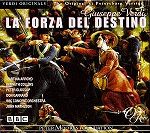 there
is now meaningful competition on CD.
Recorded in London in August 1981 the
Opera Rara account features Martina
Arroyo and Kenneth Collins as the lovers,
Peter Glossop as Carlo, Janet Coster
a vibrant Preziosilla and Don Garrard
a solid Father Guardian, all idiomatically
conducted by John Matheson. Recorded
without audience it has many virtues
and is an ideal complement to the St
Petersburg DVD. Review.
there
is now meaningful competition on CD.
Recorded in London in August 1981 the
Opera Rara account features Martina
Arroyo and Kenneth Collins as the lovers,
Peter Glossop as Carlo, Janet Coster
a vibrant Preziosilla and Don Garrard
a solid Father Guardian, all idiomatically
conducted by John Matheson. Recorded
without audience it has many virtues
and is an ideal complement to the St
Petersburg DVD. Review.
With the glory of St
Petersburg in his ears, not to mention
its honours and generous fees in his
bank, Verdi returned to Paris. He did
not attend the Italian premiere of the
opera in Rome under the title of Don
Alvaro. The Papal Censor was still
interfering and Verdi was also disappointed
by the casting by the impresario Jacovacci,
particularly of the role of Melitone.
Instead, he and Giuseppina travelled
to Madrid where he conducted the Spanish
premiere on 13 January. It was well
received by the public. The press however,
considered that it desecrated the Duke
of Rivas’s play. The elderly author,
present in the audience on the first
night, shared that view. Contrary to
some statements, Verdi did not withdraw
the St Petersburg score from further
performances in Italy after the premiere
in Rome. The version was seen in several
Italian cities in 1863 as well as in
Madrid again in 1864 and in Vienna in
1865. It was reprised in St Petersburg,
with largely the same cast, in the two
seasons following its premiere. Verdi
did, however, withhold the score from
theatres that he considered incapable
of doing it justice. It is evident that
he recognised the need for alterations
early on when he transposed the tenor
aria in act 3 downward on the basis
that only Tamberlick was capable of
meeting its demands. He instructed his
publisher, Ricordi, to include the alteration
in the scores he hired out. Verdi was
unhappy with other aspects of the score
as it stood, particularly the three
violent deaths in the final scene. When
in Paris negotiating for Don Carlos,
Perrin, the director of the Opéra
raised the question of a French version,
with the addition of a ballet. After
some consideration Verdi declined the
opportunity, as he considered that additions
would make the work too long. Already
the performing practice in Italy included
excision of the quarrel duet. Not until
after the revision of Macbeth
and the composition of Don Carlos
did Verdi find a way forward when Tito
Ricordi proposed a revival for the 1869
La Scala carnival season. By then Piave,
the original librettist, had suffered
a stroke that paralysed him for the
last eight years of his life during
which Verdi provided much financial
help to his family. The task of versifying
the revisions fell to Antonio Ghislanzoni
who the composer had met at the time
of the writing of Attila and
with whom he developed a cordial relationship.
The revised
La Forza del Destino was
premiered at La Scala on 27 February
1869. The presentation marked a rapprochement
between Verdi and the theatre and the
revision and performances are considered
here out of calendar order. The alterations
of the score from the original version
are significant rather than major. They
involved the substitution of the prelude
by a full overture, which nowadays is
often played as a concert piece. A major
revision of the end of act three includes
the removal of the demanding tenor double
aria whilst the whole final scene is
amended avoiding the triple deaths.
It is replaced by the Father Guardian’s
benediction as Leonora dies and Alvaro
is left alive. Made in 1954, La Forza
del Destino was Callas’s first Verdi
opera recording under her contract for
EMI (556323). It has remained at full
price ever since, despite the poor recording
and inadequate colleagues. Needless
to say Callas brings many insights to
Leonora’s plight but I find these no
compensation in a role that needs a
bigger voice and purer tone. Decca came
into the field with a stereo version
featuring Tebaldi in glorious voice
with the other roles all well taken.
This performance is worth hearing for
her assumption of Leonora and that of
Bastianini as Carlo (421 592-2). Strangely
Decca competed against themselves by
issuing RCA’s recording with Milanov,
somewhat past her best as Leonora; Richard
Tucker, Callas’s Alvaro, repeats his
rather inelegant assumption. This version
has not to my knowledge made it onto
CD. RCA went back into the studios in
1964 with Leontyne Price in pristine
voice as a superb Leonora in an all-American
cast conducted by Thomas Schippers.
This recording is also distinguished
by the young Shirley Verrett as Preziosilla
and the strong singing of Robert Merrill
as Carlo. Tucker, again, as Alvaro is
better than on his other two studio
recordings (GD 87971). In 1969, with
a carefully considered international
cast, EMI at last ventured their first
stereo version. With Carlo Bergonzi
replacing the scheduled contracted company
artist, his is the most elegantly sung
and phrased as well as tonally beautiful
recorded Alvaro of any on record. Cappuccilli is a strong Italianate
Carlo whilst his compatriot Raimondi
is sometimes a little vocally ponderous
as he seeks tonal sonority. Whilst Martina
Arroyo does not match the glorious tone
of Price on her first recording, hers
is a Leonora with the capacity to soar
over the orchestra and characterise
well. With that ever-idiomatic Verdian
Lamberto Gardelli on the rostrum, and
although not perfect in all its casting,
it remains my personal favouriteaudio
recording (567124-2 not
reviewed). RCA recorded Leontyne
Price as Leonora again in 1976 alongside
the young Domingo with James Levine
on the rostrum. Levine’s interpretation
is more dramatic than Gardelli’s but
not over-driven in the manner of his
earliest Verdi recordings. Price’s Leonora
has many virtues but does not match
her earlier recorded assumption. Domingo
is a vocally strong and young-sounding
Alvaro and with Sherrill Milnes as Carlo
and Fiorenza Cossotto adding quality
interpretations this a very competitive
set (74321 39502-2).
record. Cappuccilli is a strong Italianate
Carlo whilst his compatriot Raimondi
is sometimes a little vocally ponderous
as he seeks tonal sonority. Whilst Martina
Arroyo does not match the glorious tone
of Price on her first recording, hers
is a Leonora with the capacity to soar
over the orchestra and characterise
well. With that ever-idiomatic Verdian
Lamberto Gardelli on the rostrum, and
although not perfect in all its casting,
it remains my personal favouriteaudio
recording (567124-2 not
reviewed). RCA recorded Leontyne
Price as Leonora again in 1976 alongside
the young Domingo with James Levine
on the rostrum. Levine’s interpretation
is more dramatic than Gardelli’s but
not over-driven in the manner of his
earliest Verdi recordings. Price’s Leonora
has many virtues but does not match
her earlier recorded assumption. Domingo
is a vocally strong and young-sounding
Alvaro and with Sherrill Milnes as Carlo
and Fiorenza Cossotto adding quality
interpretations this a very competitive
set (74321 39502-2).
The digital age brought
two final recordings of note of La
Forza del Destino and also
frustration to the prospective purchaser.
The frustration came in the form of
nearly simultaneously recorded and issued
performances and the split of an ideal
cast. EMI set up recording sessions
in London with the Philharmonia Orchestra.
These were to be conducted by Muti who
had earlier made several admired Verdi
recordings for the company with that
orchestra. But Muti decamped for La
Scala to succeed Abbado, Sinopoli took
over the orchestra and DG took over
the recording with him on the rostrum.
EMI then set up live sessions at La
Scala under Muti featuring Domingo and
Freni as the lovers and the vocally
graceful Zancanaro as Carlo. Domingo,
with many Otellos under his belt,
sings strongly but Freni just hasn’t
got the heft and sounds seriously strained.
Muti’s hectic speeds, the dry La Scala
acoustic, add the inadequacies of a
woolly-toned and wobbly Father Guardian
and a weak Melitone and this set is
best avoided (747485-2). The Sinopoli
recording fares significantly better
in respect of soloists with Rosalind
Plowright singing powerfully as Leonora,
Agnes Baltsa’s tangy mezzo ideal for
the gypsy and Bruson and Burchuladze,
despite the latter’s glottal delivery,
far superior to their EMI rivals. The
whole is recorded in a warm acoustic
with Sinopoli showing more feel for
Verdian line than on his recorded Nabucco.
Regrettably the good news stops there.
Carreras as Alvaro is seriously over-parted.
His singing is far too often strained
and unsteady to the extent that I personally
cannot listen to him in this role (DG
419 203-2).
At the time of writing
two DVD issues of the revised
version of La Forza del Destino
are readily available. Both exemplify
something of performance practice in
respect of either 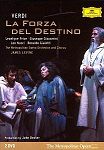 sequencing
or cuts. The Met recording of 1984,
in sets dating back to 1952, features
Leontyne Price, perhaps the greatest
Verdi soprano of her generation. She
had dominated performances of the role
at the Met since she first sang it there
in the 1967-68 season with Corelli as
Alvaro. She had to overcome racial prejudice
to become one of the most loved singers
in the company’s roster and the performance
recorded is from her last assumption
of the role. She is not in the vocal
condition of her 1976 audio recording
let alone her pristine condition of
1964. Nonetheless, hers is an assumption
worth having. Levine conducts. (Review).
The performance is given in three acts
with a reordering of the original act
three which finishes with the recognition
and duel duet between Alvaro and Carlo
rather than Preziosilla’s Rataplan.
An earlier DVD in black and white dating
from 1958 has Renata Tebaldi alongside
Franco Corelli as the lovers with Bastianini
as Carlo and Christoff as Padre Giardano.
This cast of great singers makes it
a classic for collectors.
sequencing
or cuts. The Met recording of 1984,
in sets dating back to 1952, features
Leontyne Price, perhaps the greatest
Verdi soprano of her generation. She
had dominated performances of the role
at the Met since she first sang it there
in the 1967-68 season with Corelli as
Alvaro. She had to overcome racial prejudice
to become one of the most loved singers
in the company’s roster and the performance
recorded is from her last assumption
of the role. She is not in the vocal
condition of her 1976 audio recording
let alone her pristine condition of
1964. Nonetheless, hers is an assumption
worth having. Levine conducts. (Review).
The performance is given in three acts
with a reordering of the original act
three which finishes with the recognition
and duel duet between Alvaro and Carlo
rather than Preziosilla’s Rataplan.
An earlier DVD in black and white dating
from 1958 has Renata Tebaldi alongside
Franco Corelli as the lovers with Bastianini
as Carlo and Christoff as Padre Giardano.
This cast of great singers makes it
a classic for collectors.
Rather late in the
day and when the composition of the
original version of La Forza del
Destino was well under way, Verdi
received a suggestion from his well-read
friend Andrea Maffei alerting him to
an unfinished play by Schiller that
might be of interest to the Russians.
The play was The False Demetrius,
which deals with Boris Godunov and the
struggle over imperial succession. Verdi
later commented on it favourably. Had
Verdi chosen it the course of Russian
opera might have been very different.
Whilst recognising the Russian influence
on La Forza del Destino, particularly
in Verdi’s choral writing, it is equally
important to recognise the episodic
nature of the work as an influence on
Mussorgsky’s composition of the Boris
story and also that of other Russian
composers. As it was, their emergence
saw the gradual decline in Italian opera
in St Petersburg, accelerated by the
emergence of the Mariinsky, although
Verdi’s operas continued to be performed
in that theatre alongside those of the
Russian school.
After the performances
of La Forza del Destino in Madrid
in February 1863, Verdi and Giuseppina
toured Spain before returning to Paris
where Verdi was to rehearse Les Vêpres
Siciliennes for performances at
The Opéra and for which he had
composed a new romance. The conductor
and orchestra refused to rehearse to
Verdi’s satisfaction. The composer had
been rehearsing at the piano with the
singers for over three months and he
walked out. The same conductor, who
had been responsible for a disastrous
Tannhäuser two years earlier,
was dismissed. Verdi and his wife returned
to Italy with the composer swearing
never to deal with the Paris Opéra
again. After Parliamentary business
in Turin Verdi resumed his preferred
life as a country gentleman farmer at
Sant’Agata.
The Verdis went, as
usual, to Genoa for the winter of 1863-64
with trips to the Turin Parliament when
his attendance was required. Whilst
in Genoa Verdi was visited by his Paris
representative Léon Escudier
who informed him that Paris’s Théâtre
Lyrique had enquired if the composer
would write ballet music for insertion
into Macbeth, his 10th
opera of 1847, (see PART
2) for performance at the
theatre. Later, when a formal approach
was made, Verdi’s response was more
than Escudier could have hoped for,
indicating that the composer wished
to undertake a radical revision, in
French, of the opera he had written
eighteen years before. Verdi’s proposals
for the revised Macbeth
included new arias for Lady Macbeth
and her husband and a new last act finale
deleting Macbeth’s death scene. There
were other detailed revisions as well.
The composer did not attend the premiere
on 21 April 1865 but it met with mixed
success as it did in Italian translation
elsewhere. Audiences had become used
to the sonorities of Un Ballo in
Maschera and La Traviata
and the unrevised parts of the work
do stand out in their relative musical
immaturity, harking back to the Risorgimento
operas. However, it is in this revised
form that the opera is performed, in
Italian, in the present day, often with
the re-insertion of at least Macbeth’s
death scene. This is also the situation
in respect of audio and video recordings.
The neglect of Macbeth,
Verdi’s first Shakespearean opera, continued
until the Verdi revival in Germany in
the 1920s. Its premiere in England was
not until 1938 at Glyndebourne under
Fritz Busch. La Scala mounted it in
1952 for Callas whilst the first performance
at New York’s Metropolitan Opera did
not take place until 1959. This New
York performance was the basis for the
recording issued the following year
by RCA with Leinsdorf conducting Leonie
Rysanek’s lyrical Lady and Leonard Warren’s
dark brooding Macbeth. (GD 84516). Decca
followed in 1964 with Giuseppe Taddei,
one of the best Macbeth’s on record,
and Birgit Nilsson’s gleaming tones
cutting through the textures as a rather
wilful queen. Regrettably Decca allowed
the conductor, Thomas Schippers, to
make brutal cuts. The company tried
again five years later whilst attempting
to repeat the success of their Nabucco
by featuring Elena Souliotis alongside
Tito Gobbi under Gardelli’s baton. The
best-laid plans went awry when Gobbi
called off ill and Fischer-Dieskau was
substituted. Souliotis’s singing is
wayward and Fischer-Dieskau’s affected.
Gardelli is superb and Pavarotti and
Ghiaurov lend good support to an enterprise
that failed despite the best efforts
(440 048-2).
With the revised Macbeth
firmly established in opera house repertoires
other recordings were bound to follow.
La Scala staged the work in 1975 under
Abbado in a widely acclaimed production
by Giorgio Strehler. With Abbado a contracted
artist, DG rushed to record the work
in January 1976. With the La Scala theatre
not available during the season they
used the part-completed Centro Telicinematografico
Culturale in Milan to produce a warm
yet detailed acoustic. Abbado’s conducting
is idiomatic and vibrant and set a theatrical
benchmark for his soloists. As the Queen,
Shirley Verrett is smoky-toned and musically
correct, perhaps lacking a little of
the vocal wildness that Verdi had in
mind and specified for 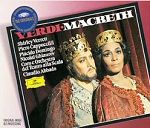 the
role. Cappuccilli as Macbeth is characterful
and expressive, just the odd moment
of dry tone intruding, but without Leonard
Warren’s vocal power. Ghiaurov’s bass
is a rock-solid tower of strength whilst
Domingo as Macduff sings an eloquent
lament for his lost family in a vocally
commanding performance (DG Originals
449 732-2). A disappointment for me
in this performance is the relative
vocal passivity of the La Scala chorus,
a matter brought into stark relief in
the recording that followed within a
few months from EMI. Conducted by Riccardo
Muti and made in London in July 1976,
it features a vibrant and involved Ambrosian
Opera Chorus with Fiorenza Cossotto
a very Italianate Queen of idiomatic
inflection and power. Sherrill Milnes’s
Macbeth is well characterised with many
felicitous vocal details. Cossotto’s
assumption is perhaps more like what
Verdi envisaged for a role in which
he was specific is eschewing tonal beauty
alone. Milnes’s juicy voice is well
suited to the role of Macbeth and only
lacks a little Italianata. Ruggero Raimondi
and José Carreras sing the other
principal roles of Banquo and Macduff,
the former having to reach for his lower
notes and the latter a little stretched
at times (5 567128 2). Unlike Abbado
who includes Macbeth’s death aria, Muti
sticks strictly to the revised 1865
version. On a personal level I own both
Abbado’s and Muti’s mid-price issues
and my affections swing between the
two recordings. Sinopoli’s digitally
recorded version for Philips has never
appealed to me as a rival to the DG
or EMI issues despite my fondness for
Bruson’s Macbeth. Sinopoli’s exaggerated
tempi and Neil Schicoff’s penny plain
Macduff are not to my liking. I also
find Mara Zampieri’s tone too hooty.
It is a pity that a contretemps between
conductor and scheduled soprano deprives
us of Ghena Dimitrova’s queen (Review).
the
role. Cappuccilli as Macbeth is characterful
and expressive, just the odd moment
of dry tone intruding, but without Leonard
Warren’s vocal power. Ghiaurov’s bass
is a rock-solid tower of strength whilst
Domingo as Macduff sings an eloquent
lament for his lost family in a vocally
commanding performance (DG Originals
449 732-2). A disappointment for me
in this performance is the relative
vocal passivity of the La Scala chorus,
a matter brought into stark relief in
the recording that followed within a
few months from EMI. Conducted by Riccardo
Muti and made in London in July 1976,
it features a vibrant and involved Ambrosian
Opera Chorus with Fiorenza Cossotto
a very Italianate Queen of idiomatic
inflection and power. Sherrill Milnes’s
Macbeth is well characterised with many
felicitous vocal details. Cossotto’s
assumption is perhaps more like what
Verdi envisaged for a role in which
he was specific is eschewing tonal beauty
alone. Milnes’s juicy voice is well
suited to the role of Macbeth and only
lacks a little Italianata. Ruggero Raimondi
and José Carreras sing the other
principal roles of Banquo and Macduff,
the former having to reach for his lower
notes and the latter a little stretched
at times (5 567128 2). Unlike Abbado
who includes Macbeth’s death aria, Muti
sticks strictly to the revised 1865
version. On a personal level I own both
Abbado’s and Muti’s mid-price issues
and my affections swing between the
two recordings. Sinopoli’s digitally
recorded version for Philips has never
appealed to me as a rival to the DG
or EMI issues despite my fondness for
Bruson’s Macbeth. Sinopoli’s exaggerated
tempi and Neil Schicoff’s penny plain
Macduff are not to my liking. I also
find Mara Zampieri’s tone too hooty.
It is a pity that a contretemps between
conductor and scheduled soprano deprives
us of Ghena Dimitrova’s queen (Review).
On DVD one of
the most enjoyable performances of Macbeth
is one of the oldest, that from Glyndebourne
in 1972 and directed by Michael Hadjimischev.
The sets are evocative and the passing
of the Kings eerily effective. It features
the fine Greek baritone Kostas Paskalis
as Macbeth and Josephine Barstow as
a superbly acted queen with John Pritchard
pacing the drama well. Apart from the
4:3 format and dated colours, a major
drawback is the performance cuts. At
125 minutes too much good music, mainly
of the witches, is left behind (Arthaus
101095). From the same stable is the
DVD cousin of Philips’ audio recording.
Conducted by Sinopoli
from performances at Deutsche Oper Berlin
in 1987 and directed Luca Ranconi it
has Bruson and Zampieri as the plotters
with James Morris as Banquo and Dennis
O’Neill as Macduff. At 150 minutes playing
time it is comparable to the audio recordings
referred to (Arthaus 100140). Later
recordings include a 2002 performance
from Zurich conducted Franz Welser-Möst
in a production by David Pountney whose
version at the English National Opera
caused furore with its green blood dripping
from the dagger. He cannot escape gimmicks
here either with the witches having
outlandish hairdos and spectacles and
seeming to live in a suburban world
that does not lie easily with Verdi’s
music. The production focuses on the
erotic relationship between Macbeth
and his spouse. In that role Paoletta
Marrocu gives a particularly convincing
performance vocally and histrionically.
The 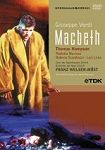 singing
of Thomas Hampson as Macbeth is impressive
with Roberto Scandiuzzi and Luis Lima
giving support. The quoted time of 185
minutes includes 45 minutes of interviews
from singers and production team convincing
each other of the virtues of the staging
(TDK DV-OPMAC). The most recent recorded
performance is that of Phyllida Lloyd’s
production at Barcelona in 2005 with
Carlos Alvarez firm of voice as Macbeth
and Maria Guleghina a powerful Queen
(Opus Arte OA 0922D). Bruno Campanella
on the rostrum does not always keep
the orchestra on its toes and the chorus
singing could be much better.
singing
of Thomas Hampson as Macbeth is impressive
with Roberto Scandiuzzi and Luis Lima
giving support. The quoted time of 185
minutes includes 45 minutes of interviews
from singers and production team convincing
each other of the virtues of the staging
(TDK DV-OPMAC). The most recent recorded
performance is that of Phyllida Lloyd’s
production at Barcelona in 2005 with
Carlos Alvarez firm of voice as Macbeth
and Maria Guleghina a powerful Queen
(Opus Arte OA 0922D). Bruno Campanella
on the rostrum does not always keep
the orchestra on its toes and the chorus
singing could be much better.
Section
2. Don Carlos
and Don Carlo. The original French
version of 1867 to the Modena version
of 1886 in Italian.
Back in Busseto after
the premiere of the revised Macbeth,
Verdi found himself in dispute with
his town. They had, over the previous
six years, constructed a municipal theatre,
and assumed that the composer would
allow it to be named after him. For
his part, although originally supportive,
he had thought construction should have
been put off and the funds used to support
the earlier war against the Austrians.
Feeling coerced he at first refused
before relenting and in August donating
a sizeable cheque. Although a box was
put at his disposal he never entered
the theatre. That same month, having
vowed never to have anything to do with
the Paris Opéra again, Verdi
was persuaded to relent and signed a
contract to give a revised La Forza
del destino and also compose a new
opera for that theatre. After resigning
from the National Assembly in September
and spending time in Genoa he and his
wife arrived in Paris on 1 December
1865. After considering several subjects,
including, yet again King Lear, Verdi
settled on Schiller’s Don Carlos,
Infant von Spanien of 1787. Verdi
stayed in Paris until March 1866 working
with the librettists Joseph Méry
and Camille Du Locle, the former dying
a few months later. When Verdi returned
to Busseto the libretto was virtually
complete and during the spring and summer
he worked at the music, his concentration
being disturbed by the onset of the
Third War of Independence between Italy
and Austria that started on 19 June
1865. After Italy’s defeats it needed
the Prussians to rescue the situation
with Austria making peace and ceding
Veneto first to France, and after a
plebiscite, to Italy. Verdi was greatly
upset by the manner of the acquisition
but Rome, as capital of Italy, remained
a dream.
In Paris, Perrin the
administrator of the Opéra was
manoeuvring his roster of singers so
as to make the best available for Verdi’s
new work, Don Carlos,
his 25th opera. There was
trouble with the bass assigned for the
Grand Inquisitor whilst Verdi also wanted
changes in the last act and to improve
cohesion and spectacle elsewhere. The
casting of the role of Eboli also proved
problematic. Verdi made transpositions
to accommodate the singer allocated
although the wide tessitura remains,
and as a consequence continues to be
a challenge for casting directors to
this day. At the rehearsal of the whole
opera in February 1867 it became obvious
that Don Carlos, was, at three
hours forty-seven minutes, too long
to allow time for suburban Parisians
to get their last trains home. Verdi
reluctantly excised over twenty minutes
of music. All this music was thought
lost until at the Verdi Congress in
Parma in 1969 David Rosen, an American
scholar, produced a previously unknown
section of the Philip-Posa duet that
had been folded down in the conducting
score prior to the premiere. The English
musicologist Andrew Porter, acting on
a hunch, visited the Paris Opéra
library and asked to see the score.
He was amazed to discover that the pages
of the music that Verdi omitted from
the premiere, and subsequently thought
to be lost, were simply stitched together.
These excisions give greater cohesion
and explanation of the details of the
complex story as the work unfolds. With
permission Porter copied out the missing
parts. Back in London, Julian Budden,
the renowned Verdi scholar, then Head
of BBC Classical Music, planned a recording
for broadcast purposes and including
the newly discovered parts. It was the
first public performance ever of the
opera as Verdi originally intended.
It took place before a small invited
audience on 22 April 1972. For this
unique premiere Budden assembled a cast
of mainly French-speaking singers supported
by stalwart British principals from
the London’s 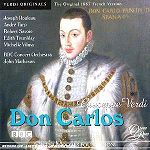 Covent
Garden and Sadler’s Wells companies.
The seminal broadcast by the BBC took
place on 10 June 1973 after which the
performance disappeared from the public
domain until its re-emergence on CD
by Opera Rara made it properly and readily
commercially available (Review).
The music had previously appeared as
an appendix to Abbado’s recording of
the original French version. With somewhat
non-idiomatic French from a mainly Italian
cast, and recorded in an over-resonant
acoustic, this performance has serious
limitations (DG 415 316-2). A more recent
CD recording from the Vienna State Opera
on 18 October 2004, conducted by Bertrand
de Billy claimed world premiere status
as the first staged performance of what
Verdi had originally intended. The production
by Peter Konwitschny was not received
well and there is much audience noise.
The singing is adequate, no more (Review).
Performances of what was seen in Paris
at the premiere, with the addition of
some excised music, were recorded in
Paris in 1996 in a production shared
with other theatres including Covent
Garden. Conducted with vigour by Antonio
Pappano it is also available on DVD
(Review)
and CD (EMI 556152 2). Karita Mattila
sings wonderfully as Elisabetta and
is well supported by Roberto Alagna
as Carlos. On CD one is spared Rodrigue’s
stupid hairstyle and can appreciate
his well-sung portrayal. Elsewhere,
particularly in respect of José
van Dam’s vocally lightweight Philip
and Waltraud Meier’s Germanic portrayal
of Eboli, the performance is flawed.
On DVD the weakness of the portrayal
of the auto-da-fé is a disappointment.
Verdi wanted spectacle in that scene
and this production by Luc Bondy fails
badly in that respect as well as being
perversely idiosyncratic elsewhere.
Covent
Garden and Sadler’s Wells companies.
The seminal broadcast by the BBC took
place on 10 June 1973 after which the
performance disappeared from the public
domain until its re-emergence on CD
by Opera Rara made it properly and readily
commercially available (Review).
The music had previously appeared as
an appendix to Abbado’s recording of
the original French version. With somewhat
non-idiomatic French from a mainly Italian
cast, and recorded in an over-resonant
acoustic, this performance has serious
limitations (DG 415 316-2). A more recent
CD recording from the Vienna State Opera
on 18 October 2004, conducted by Bertrand
de Billy claimed world premiere status
as the first staged performance of what
Verdi had originally intended. The production
by Peter Konwitschny was not received
well and there is much audience noise.
The singing is adequate, no more (Review).
Performances of what was seen in Paris
at the premiere, with the addition of
some excised music, were recorded in
Paris in 1996 in a production shared
with other theatres including Covent
Garden. Conducted with vigour by Antonio
Pappano it is also available on DVD
(Review)
and CD (EMI 556152 2). Karita Mattila
sings wonderfully as Elisabetta and
is well supported by Roberto Alagna
as Carlos. On CD one is spared Rodrigue’s
stupid hairstyle and can appreciate
his well-sung portrayal. Elsewhere,
particularly in respect of José
van Dam’s vocally lightweight Philip
and Waltraud Meier’s Germanic portrayal
of Eboli, the performance is flawed.
On DVD the weakness of the portrayal
of the auto-da-fé is a disappointment.
Verdi wanted spectacle in that scene
and this production by Luc Bondy fails
badly in that respect as well as being
perversely idiosyncratic elsewhere.
The premiere of Don
Carlos on 11 March 1867 was only
modestly received by the public and
only played for three performances more
than the contracted forty, after which
it was not seen at the Opéra
until the revival conducted by Pappano
in 1996. Meanwhile an Italian version
as Don Carlo, by Achille de Lauzières,
had been prepared the previous autumn.
In offering the rights to Tito Ricordi,
Verdi again sought to insist that it
only be made available with safeguards.
These included that it be performed
in its entirety although he was prepared
for another ballet to be substituted
for his music as long as it was played
as an add-on at the end. The first performance
in Italian was not given in Italy but
at Covent Garden on 4 June 1867. Despite
Verdi’s wishes that carried no weight
in London, it was given with the first
act and ballet removed completely along
with various other excisions. Such practices
were standard at Covent Garden as at
most other European houses. The Italian
premiere of Don Carlo at Bologna
in September 1867 was given in full,
whilst in Rome, still under Papal control,
the censor changed the Inquisitor into
a Gran Cancelliere. Despite being seen
all over the peninsula the Italians
were slow to take Don Carlo to
their hearts and it was not long before
first the ballet and then the Fontainebleau
act were dropped. The arrival in Italy
of the shorter and grander Aida
added to the difficulty of the opera’s
length and after a failure in Naples
in 1871 Verdi made his first revisions
for a revival under his own supervision.
These changes involved the dramatic
Philip-Posa duet in act 2 and it is
the only part of any version of the
opera that was not composed to a French
text. Still the fortunes of the opera
disappointed the composer and as early
as 1875 he began seriously to consider
shortening the work himself. He asked
Nuitter, archivist at the Opera and
translator into French of the revised
Macbeth and La forza del Destino,
to derive a new scenario for versifying
by du Locle, his original librettist.
With other demands, not least the commission
and writing of Aida, Verdi did
not begin serious work on this until
1882, concluding his revision into a
four act version the following March
with the premiere at La Scala having
to wait until 1884. Except for the example
quoted of the Philip-Posa duet, for
all the revisions of Don Carlos Verdi
worked from a French libretto, as he
considered the opera to be conditioned
by the prosody of the language and traditional
French metres. Angelo Zanardini, who
also revised Lauzières’ original,
put the new lines into Italian and it
has become known as the 1884 version
after it received its premiere at La
Scala in January of that year. This
four-act revision of Don Carlo,
Verdi’s own, involved much rewording
to explain the sequence of events and
maintain narrative coherence that is
otherwise seriously affected by the
removal of the original first act. Verdi
moved the act one tenor aria from the
original to the new act one. He also
removed the act three ballet, the Inquisitor’s
chorus in act five as well as making
many other detailed changes elsewhere.
The premiere of the new four act Don
Carlo was a great success and featured
the tenor Tamagno who three years later
was to create Otello.
When Don Carlo
became more popular in the 1930s it
was in the form of the four act 1884
version in Italian, many conductors
and managements seeing virtue in its
shorter length and tauter drama. The
first studio recording, by HMV in 1954
in mono, is of this four-act version
and features the formidable duo of Boris
Christoff as Philip and Tito Gobbi as
Posa, pre-eminent in their roles. Their
duet is one of the high points of recorded
opera and where the 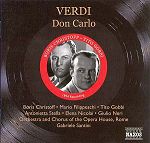 frisson
of their performance overcomes the somewhat
flaccid conducting of Santini (EMI Références
5677479-2). In 2007 this recording was
issued in bargain-priced re-masterings
from both Naxos
and Regis, the former bringing out the
sound to a remarkable degree. Karajan
favoured this four-act version and recorded
it in a red-blooded performance after
staging it at Salzburg. Mirella Freni
as Elisabetta and Carreras as Carlos
are stretched to their limits whilst
Cappuccilli’s Rodrigo in a long-breathed
death scene is formidable, an applicable
adjective also for Baltsa and Ghiaurov
as Eboli and Philip. Karajan does allow
his orchestra to overwhelm his singers
from time to time (EMI 769304 2). A
live recording from Vienna has its virtues.
It features Franco Corelli’s vocally
strong, even excessive, Carlos milking
every high note and Gundula Janowitz
as Elisabeth. This recording also has
Shirley Verrett as Eboli and Marti Talvela
as the Inquisitor and who take the real
vocal laurels (Orfeo C 649 053). A live
performance under Muti at La Scala in
1992 has Pavarotti as Carlo, Luciana
D’Intino as Eboli and Sam Ramey as Philip
in a rather uneven cast. The tenor notoriously
cracked on the opening night in what
was his debut in the role and was booed.
Fortunately for recorded posterity of
his assumption he did better in subsequent
performances, a conflation of which
is available on CD at bargain price
(EMI 3 58631-2) and also DVD
which enables appreciation of Franco
Zeffirelli’s lavish and evocative production
(EMI 99442 9). Rolando Villazon, one
of the latest and most exciting of tenors
to emerge on the international stage
sings the eponymous role on a DVD recording
of Willy Deckers’ production in Wolfgang
Gussman’s imposing unit set for Netherlands
Opera in 2004. The tenor and the conducting
of Ricardo Chailly are the main virtues
of this performance.
frisson
of their performance overcomes the somewhat
flaccid conducting of Santini (EMI Références
5677479-2). In 2007 this recording was
issued in bargain-priced re-masterings
from both Naxos
and Regis, the former bringing out the
sound to a remarkable degree. Karajan
favoured this four-act version and recorded
it in a red-blooded performance after
staging it at Salzburg. Mirella Freni
as Elisabetta and Carreras as Carlos
are stretched to their limits whilst
Cappuccilli’s Rodrigo in a long-breathed
death scene is formidable, an applicable
adjective also for Baltsa and Ghiaurov
as Eboli and Philip. Karajan does allow
his orchestra to overwhelm his singers
from time to time (EMI 769304 2). A
live recording from Vienna has its virtues.
It features Franco Corelli’s vocally
strong, even excessive, Carlos milking
every high note and Gundula Janowitz
as Elisabeth. This recording also has
Shirley Verrett as Eboli and Marti Talvela
as the Inquisitor and who take the real
vocal laurels (Orfeo C 649 053). A live
performance under Muti at La Scala in
1992 has Pavarotti as Carlo, Luciana
D’Intino as Eboli and Sam Ramey as Philip
in a rather uneven cast. The tenor notoriously
cracked on the opening night in what
was his debut in the role and was booed.
Fortunately for recorded posterity of
his assumption he did better in subsequent
performances, a conflation of which
is available on CD at bargain price
(EMI 3 58631-2) and also DVD
which enables appreciation of Franco
Zeffirelli’s lavish and evocative production
(EMI 99442 9). Rolando Villazon, one
of the latest and most exciting of tenors
to emerge on the international stage
sings the eponymous role on a DVD recording
of Willy Deckers’ production in Wolfgang
Gussman’s imposing unit set for Netherlands
Opera in 2004. The tenor and the conducting
of Ricardo Chailly are the main virtues
of this performance.
After the 1884 performances
of the four act Don Carlo a friend
asked Verdi if he did not regret the
loss of so much music from the original
score. He had already told his friend
that the new version had more concision,
more muscle and added that those
who complained about the loss of so
much beautiful music from the first
act quite possibly did not notice its
existence before. But others were less
sure and performances were given in
Modena in 1886, claimed to be with Verdi’s
permission, which reintroduced the original
act one to the 1884 revision. It was
in this five-act form, albeit with minor
cuts, that Don Carlo was launched
to the post-Second World War operatic
public in a production by Visconti and
conducted by Giulini at London’s Covent
Garden on 12 May 1958. With a first
rate cast including Christoff as the
King, Gobbi as Posa and the young Jon
Vickers as an ardent Don Carlo it made
a big impact in operatic circles and
has influenced recording and theatre
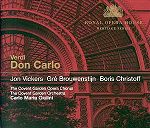 practice
ever since. The official release in
2006 of a recording in the Royal Opera
House Heritage Series of the second
of these seminal performances is particularly
welcome and is in good sound (Review).
Giulini draws from Christoff one of
the most telling performances the singer
made of the role of Philip on disc and
betters that on the first stereo recording
made when DG added the La Scala imprimatur
to their credits (NLA). Regrettably,
DG did not surround Christoff with colleagues
and a conductor of the quality heard
at Covent Garden although Cossotto’s
Eboli is first class. With Georg Solti
in charge at Covent Garden, and using
the house orchestra and chorus, Decca
recorded a five-act version in London
in the summer of 1965 with John Culshaw
as producer. In Carlo Bergonzi it features
the best-sung Carlo on record and with
Ghiaurov as Philip and Martti Talvela
as the Inquisitor the act four confrontation
is hair-raising. As Elisabeth, Renata
Tebaldi is past her very best but does
not let the side down and whilst the
casting of Fischer-Dieskau as Rodrigo
is flawed he too does not spoil an enjoyable
performance (Decca 421 114-2). Whatever
its virtues Solti’s recording was seen
to be eclipsed when Giulini recorded
the extended five act Modena version
in 1971. With the young Domingo as an
ardent Carlos, Caballé only failing
with a tentative act five Tu che
le vanita and with Milnes as Posa
and Verrett as Eboli it has many strengths
(Review).
A 1992 studio recording based on New
York Met performances conducted by Levine
with Aprille Millo a fine queen and
Chernov an excellent Rodrigo is marred
by inadequate singing elsewhere, particularly
from the basses (Sony S3K 52500). Haitink,
who had conducted the Covent Garden
performances of the French version recorded
by Pappano in Paris, got his chance
in 1996 in what is likely to be the
last studio recording of the opera.
With the Canadian Richard Margison a
lyrical Carlo and Russians as Elisabeth,
Eboli and Posa it has not lasted the
pace at full price and is now available
at bargain level (Philips 475 252-2).
Haitink is lyrical and affectionate
in his conducting yet lacking some of
the drive of Solti. I heard the London
Promenade live performance that followed
the recording with Sylvie Valayre as
a more impressive queen than Gorchakova
on the CD issue, the whole having significantly
more frisson than the studio version.
Perhaps it will become available one
day. Haitink paces Don Carlo
well on a DVD of the Covent Garden
Visconti production. Made in 1985 and
whilst not of the quality that Giulini
conducted in the production’s first
outing in 1958, the cast includes a
distinguished Rodrigo from Giorgio Zancanaro
alongside Louis Lima
as Carlos and Ileana Cotrubas
as the queen, both a little stretched
(Warner 510110242-2). The other major
DVD recording of the five-act version
is that from the Met in the mid-1980s
with Levine conducting a fine cast of
Domingo, Milnes, Grace Bumbry as Eboli
and the husband and wife team of Ghiaurov
as Philip and Freni as Elisabeth. As
with Karajan, Freni is musical but at
her vocal limits, the part being a size
to large for her. The production is
wholly appropriate and makes ideal home
viewing (DG 00440073 4083).
practice
ever since. The official release in
2006 of a recording in the Royal Opera
House Heritage Series of the second
of these seminal performances is particularly
welcome and is in good sound (Review).
Giulini draws from Christoff one of
the most telling performances the singer
made of the role of Philip on disc and
betters that on the first stereo recording
made when DG added the La Scala imprimatur
to their credits (NLA). Regrettably,
DG did not surround Christoff with colleagues
and a conductor of the quality heard
at Covent Garden although Cossotto’s
Eboli is first class. With Georg Solti
in charge at Covent Garden, and using
the house orchestra and chorus, Decca
recorded a five-act version in London
in the summer of 1965 with John Culshaw
as producer. In Carlo Bergonzi it features
the best-sung Carlo on record and with
Ghiaurov as Philip and Martti Talvela
as the Inquisitor the act four confrontation
is hair-raising. As Elisabeth, Renata
Tebaldi is past her very best but does
not let the side down and whilst the
casting of Fischer-Dieskau as Rodrigo
is flawed he too does not spoil an enjoyable
performance (Decca 421 114-2). Whatever
its virtues Solti’s recording was seen
to be eclipsed when Giulini recorded
the extended five act Modena version
in 1971. With the young Domingo as an
ardent Carlos, Caballé only failing
with a tentative act five Tu che
le vanita and with Milnes as Posa
and Verrett as Eboli it has many strengths
(Review).
A 1992 studio recording based on New
York Met performances conducted by Levine
with Aprille Millo a fine queen and
Chernov an excellent Rodrigo is marred
by inadequate singing elsewhere, particularly
from the basses (Sony S3K 52500). Haitink,
who had conducted the Covent Garden
performances of the French version recorded
by Pappano in Paris, got his chance
in 1996 in what is likely to be the
last studio recording of the opera.
With the Canadian Richard Margison a
lyrical Carlo and Russians as Elisabeth,
Eboli and Posa it has not lasted the
pace at full price and is now available
at bargain level (Philips 475 252-2).
Haitink is lyrical and affectionate
in his conducting yet lacking some of
the drive of Solti. I heard the London
Promenade live performance that followed
the recording with Sylvie Valayre as
a more impressive queen than Gorchakova
on the CD issue, the whole having significantly
more frisson than the studio version.
Perhaps it will become available one
day. Haitink paces Don Carlo
well on a DVD of the Covent Garden
Visconti production. Made in 1985 and
whilst not of the quality that Giulini
conducted in the production’s first
outing in 1958, the cast includes a
distinguished Rodrigo from Giorgio Zancanaro
alongside Louis Lima
as Carlos and Ileana Cotrubas
as the queen, both a little stretched
(Warner 510110242-2). The other major
DVD recording of the five-act version
is that from the Met in the mid-1980s
with Levine conducting a fine cast of
Domingo, Milnes, Grace Bumbry as Eboli
and the husband and wife team of Ghiaurov
as Philip and Freni as Elisabeth. As
with Karajan, Freni is musical but at
her vocal limits, the part being a size
to large for her. The production is
wholly appropriate and makes ideal home
viewing (DG 00440073 4083).
Section 3. Aida
and The Requiem.
Over the nineteen years
that elapsed whilst Verdi made his revisions
of Don Carlos much happened to
him and to Italy. On 14 January 1867
whilst Verdi was in Paris preparing
the premiere of the opera his father
died. Back at Busseto after the March
premiere he worked on his farm, which
he wanted to be a model for the district.
He was not in a happy frame of mind,
dissatisfied with the reception of Don
Carlos and a host of niggles elsewhere.
In May Giuseppina went to Milan to buy
furniture for their new apartment in
Genoa and unknown to Verdi called on
his long-time friend the Countess Maffei.
Verdi and she had corresponded regularly
but had not met for over twenty years;
the two ladies had never met. They got
on famously and together went to see
Alessandro Manzoni who Verdi revered
and described, alongside Rossini, as
one of the two greatest living Italians.
Verdi had read Manzoni’s novel ‘I Promessi
Sposi’ when aged sixteen and in his
fifty-third year he wrote to a friend,
according to me, (he) has written
not only the greatest book of our time
but one of the greatest books that ever
came out of the human brain. The
novel has been described as representing
for Italians all of Scott, Dickens and
Thackeray rolled into one and infused
with the spirit of Tolstoy. It was not
merely the nature of Manzoni’s partly
historical story that gave the work
this ethos, but the language. With it
Manzoni made vital steps towards a national
Italian language to replace the proliferation
of dialects and foreign administrative
languages extant in the peninsula. Giuseppina
returned from Milan with a signed photograph
from Manzoni and an invitation to Verdi
to visit him.
In July 1867 Verdi’s
niggles of mind over Don Carlos
and difficulties with the Town Council
of Busseto were put in perspective when
Barezzi died aged 79. He was not only
the father of Verdi’s first wife Margherita,
but also the benefactor without whose
financial support Verdi would never
have attained the heights he did. The
composer and Giuseppina were at his
bedside where Verdi played Va pensiero
on the piano at the dying man’s last
wish. After Barezzi’s death Verdi asked
a friend to search in Milan for the
graves of Margherita and his young son
Icilio. The report came back that these
had long ago been opened and the remains
interred in a common grave. In Busseto
the grave of his daughter Victoria had
also been lost, perhaps in the same
way. All Verdi had of the past were
the marriage rings he and Margherita
had exchanged, together with two pieces
of her jewellery. Verdi kept these mementos
in a little copper box. To these poignant
artefacts he added a lock of Barezzi’s
hair. On the box he wrote mementos
of my poor family.
After Barezzi’s funeral,
Verdi and Giuseppina went to Paris to
see the Great Exposition and also the
latest sites in the rebuilding and reordering
under Haussemann. As well as the usual
tourist itinerary, which included the
city’s new modern sewer system, the
Verdis also visited  the
magnificent building for the Opéra.
Designed by Garnier at Napoleon III’s
behest it did not, as a consequence
of war and political changes, open until
1875. Recently refurbished it is a highlight
of any trip to Paris in the present
day. For the rest of 1867 and the early
part of the following year Verdi’s life
followed uneventfully in the usual domestic
cycle. In the spring of 1868 he and
Giuseppina went to Milan. It was Verdi’s
first visit since the cinque giornate
of 1848. Verdi at last realised a dream
and went to meet the ageing Manzoni.
How the two great Italians greeted and
spent their time together is not recorded.
On their return to Busseto, Du Locle,
one of the librettists of Don Carlos,
and with whom a warm friendship had
developed, visited the Verdis. In the
years that followed du Locle, who never
despaired of tempting Verdi into another
collaboration, kept sending him ideas
as to possible projects one of which
was to come to magnificent fruition.
the
magnificent building for the Opéra.
Designed by Garnier at Napoleon III’s
behest it did not, as a consequence
of war and political changes, open until
1875. Recently refurbished it is a highlight
of any trip to Paris in the present
day. For the rest of 1867 and the early
part of the following year Verdi’s life
followed uneventfully in the usual domestic
cycle. In the spring of 1868 he and
Giuseppina went to Milan. It was Verdi’s
first visit since the cinque giornate
of 1848. Verdi at last realised a dream
and went to meet the ageing Manzoni.
How the two great Italians greeted and
spent their time together is not recorded.
On their return to Busseto, Du Locle,
one of the librettists of Don Carlos,
and with whom a warm friendship had
developed, visited the Verdis. In the
years that followed du Locle, who never
despaired of tempting Verdi into another
collaboration, kept sending him ideas
as to possible projects one of which
was to come to magnificent fruition.
During 1868 Verdi was
not compositionally idle. As I have
indicated above, he had long wanted
to revise La Forza del Destino
and when Tito Ricordi proposed a revival
for the 1869 La Scala carnival season
he accepted. The revised opera was premiered
at La Scala on 27 February 1869 and
marked a rapprochement between Verdi
and the theatre after a hiatus of twenty-five
years. But for Verdi 1868 did not go
out without a sting in its tail when,
on 13 November, Rossini died aged 76.
The two, whilst not close, were friends.
Rossini had once written in a letter
to Verdi, Rossini, ex-composer and
pianist of the fourth class, to the
illustrious composer Verdi, pianist
of the fifth class. Verdi wrote
to the Countess Maffei Rossini’s
reputation was the most widespread and
popular of our time; it was one of the
glories of Italy. When the other like
it (Manzoni’s) no longer exists,
what will remain of us. Even before
the Memorial Service had been held in
Paris, Verdi wrote to Milan’s Gazzetta
Musicale suggesting that the musicians
of Italy should unite to honour their
great compatriot by combining to write
a Requiem for performance on the anniversary
of his death. No one would receive payment
for his contribution with volunteers
to each write one section of the Mass
being drawn by lot. After the performance,
which Verdi recognised would lack artistic
unity, the score was to be sealed up
in the Bologna Liceo Musico, Rossini’s
home town. The idea was enthusiastically
received and a committee set up to 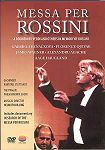 oversee
the project. To Verdi, pre-eminent among
the names, fell the closing section,
the Libera Me. He had his composition
ready in good time despite revising
La Forza del Destino along the
way. Problems arose in respect of the
chorus and orchestra, for which Verdi,
somewhat unfairly, blamed his friend
the conductor Mariani and the project
floundered. Verdi met the costs incurred.
A Warner Vision issue (50-51011 7396-2-0)
of a performance of this original Rossini
Requiem is reviewed by a colleague Full
Review.
oversee
the project. To Verdi, pre-eminent among
the names, fell the closing section,
the Libera Me. He had his composition
ready in good time despite revising
La Forza del Destino along the
way. Problems arose in respect of the
chorus and orchestra, for which Verdi,
somewhat unfairly, blamed his friend
the conductor Mariani and the project
floundered. Verdi met the costs incurred.
A Warner Vision issue (50-51011 7396-2-0)
of a performance of this original Rossini
Requiem is reviewed by a colleague Full
Review.
Whilst Verdi resisted
du Locle’s overtures to compose for
the Paris Opéra he did consider
doing so for the Opéra Comique.
But then in late 1869 du Locle brought
along a more interesting proposal. He
told Verdi that the Khedive (Viceroy)
of Egypt wanted the composer to write
an opera on an Egyptian theme for performance
at the new opera house in  Cairo
constructed to celebrate the construction
of the Suez Canal. The theatre had opened
in November 1869 [a
copy of La Scala Milan itburnt down
in 1971] with a performance of
Rigoletto conducted by Verdi’s
former pupil Emanuele Muzio. The Suez
Canal was officially opened on the 17th
of the same month. Verdi at first turned
down the request repeating his refusal
when in Paris the following spring.
But Du Locle was not deterred and sent
Verdi a synopsis by Mariette, a French
national and renowned Egyptologist in
the employ of the Khedive. Stimulated
by the synopsis, and also, perhaps,
by the fact that Du Locle had been authorised
to approach Gounod or Wagner if he continued
to prove reluctant, Verdi wrote to Du
Locle on 2 June 1870 setting out his
terms. These stipulated his control
and ownership of the libretto, and that
he, Verdi, retained all rights except
for performances in Egypt. He also stipulated
a fee of 150,000 Francs, payable at
the Rothschild Bank in Paris on delivery
of the work. Mariette announced acceptance
of these terms to Du Locle on 10 June.
The fee made Verdi the highest paid
composer ever. Du Locle met Verdi at
Sant’Agata soon after and thrashed out
an outline of the opera in prose based
on Mariette’s earlier synopsis. Verdi
asked his publisher, Ricordi, to approach
Ghislanzoni to put it into Italian verse.
Throughout the process the composer
was keen to achieve the greatest historical
accuracy. For example he asked Du Locle
to gather information from Mariette
about the sacred dances of the Egyptian
priestesses. Verdi was intent on a Grand
Opera of spectacle and ballet as though
he were writing for the Paris Opéra.
Cairo
constructed to celebrate the construction
of the Suez Canal. The theatre had opened
in November 1869 [a
copy of La Scala Milan itburnt down
in 1971] with a performance of
Rigoletto conducted by Verdi’s
former pupil Emanuele Muzio. The Suez
Canal was officially opened on the 17th
of the same month. Verdi at first turned
down the request repeating his refusal
when in Paris the following spring.
But Du Locle was not deterred and sent
Verdi a synopsis by Mariette, a French
national and renowned Egyptologist in
the employ of the Khedive. Stimulated
by the synopsis, and also, perhaps,
by the fact that Du Locle had been authorised
to approach Gounod or Wagner if he continued
to prove reluctant, Verdi wrote to Du
Locle on 2 June 1870 setting out his
terms. These stipulated his control
and ownership of the libretto, and that
he, Verdi, retained all rights except
for performances in Egypt. He also stipulated
a fee of 150,000 Francs, payable at
the Rothschild Bank in Paris on delivery
of the work. Mariette announced acceptance
of these terms to Du Locle on 10 June.
The fee made Verdi the highest paid
composer ever. Du Locle met Verdi at
Sant’Agata soon after and thrashed out
an outline of the opera in prose based
on Mariette’s earlier synopsis. Verdi
asked his publisher, Ricordi, to approach
Ghislanzoni to put it into Italian verse.
Throughout the process the composer
was keen to achieve the greatest historical
accuracy. For example he asked Du Locle
to gather information from Mariette
about the sacred dances of the Egyptian
priestesses. Verdi was intent on a Grand
Opera of spectacle and ballet as though
he were writing for the Paris Opéra.
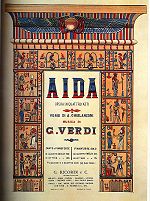 Aida,
Verdi’s 26th opera was
ready for premiere in Egypt in January
1871, but a war distant from Egypt,
intervened. Bismarck had engineered
a Franco-Prussian confrontation in Autumn
1870. The French army was defeated at
the Battle of Sedan and the Emperor
Napoleon III captured. With Paris under
siege the scenery constructed there
could not be got out and shipped to
Cairo. Although Verdi’s composition
was completed Aida was not premiered
until Christmas Eve 1871. This delay
also caused the postponement of the
Italian premiere at La Scala as the
contract stipulated that the first performances
of the opera would be given in the Cairo
Opera House.
Aida,
Verdi’s 26th opera was
ready for premiere in Egypt in January
1871, but a war distant from Egypt,
intervened. Bismarck had engineered
a Franco-Prussian confrontation in Autumn
1870. The French army was defeated at
the Battle of Sedan and the Emperor
Napoleon III captured. With Paris under
siege the scenery constructed there
could not be got out and shipped to
Cairo. Although Verdi’s composition
was completed Aida was not premiered
until Christmas Eve 1871. This delay
also caused the postponement of the
Italian premiere at La Scala as the
contract stipulated that the first performances
of the opera would be given in the Cairo
Opera House.
Aida is one
of Verdi’s most popular of operas with
its blend of musical invention and dramatic
expression. It is a work of pageant
with its Grand March (Gloria all’Egitto)
and ballet interludes. The music is
melodic and evocative from the outset.
The story is taut in its drama with
no superfluity of verbiage. Above all
it is a work involving various personal
relationships. That between the Ethiopian
Princess Aida, acting incognito as a
slave to Amneris the daughter of the
Egyptian King, and who both love the
soldier Radames is the core of the opera.
But Verdi always loved the complexities
and possibilities of the father-daughter
relationship and examples occur throughout
his operas; nowhere more starkly than
in Aida.
The luxuriant music
and pageant of Aida have drawn
recordings from the days of 78s with
a rapid expansion following the advent
of the LP. Likewise there are several
worthy DVDs to choose from. On 78s the
performance involving the Radames of
Gigli alongside Maria 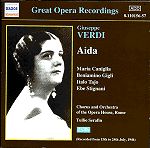 Caniglia
as Aida, Ebe Stignani as Amneris and
recorded in Rome in 1946 under Serafin
stands out although the recording favours
the singers. Ward Marston’s remastering
for Naxos cannot disguise original faults
but it is worth hearing (Review).
The first twenty-five or so years of
the LP era saw the record companies
compete with themselves, with repeat
recordings, as well as with their rivals.
The first LP recordings were inevitably
in mono with each company fielding their
contracted diva in the title role. Decca
were early into the field with their
FFSS superior sound derived from having
signed some of the best electronic whiz
kids from world war two. Their diva
was Renata Tebaldi who Toscanini had
invited to sing at the reopening
Caniglia
as Aida, Ebe Stignani as Amneris and
recorded in Rome in 1946 under Serafin
stands out although the recording favours
the singers. Ward Marston’s remastering
for Naxos cannot disguise original faults
but it is worth hearing (Review).
The first twenty-five or so years of
the LP era saw the record companies
compete with themselves, with repeat
recordings, as well as with their rivals.
The first LP recordings were inevitably
in mono with each company fielding their
contracted diva in the title role. Decca
were early into the field with their
FFSS superior sound derived from having
signed some of the best electronic whiz
kids from world war two. Their diva
was Renata Tebaldi who Toscanini had
invited to sing at the reopening 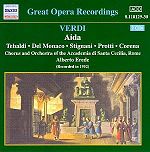 of
La Scala in 1947. She is in fresher
voice than in the 1959 stereo remake
under Karajan. As Radames, Mario del
Monaco is his usual stentorian self.
Mark Obert-Thorn’s remastering makes
what he can of Santa Cecilia’s rather
confined acoustic (Review).
America’s RCA featured the Yugoslav
dramatic soprano Zinka Milanov as Aida
alongside the tasteful Jussi Björling
as Radames and the redoubtable Leonard
Warren and Fedora Barbieri as Amonasro
and
of
La Scala in 1947. She is in fresher
voice than in the 1959 stereo remake
under Karajan. As Radames, Mario del
Monaco is his usual stentorian self.
Mark Obert-Thorn’s remastering makes
what he can of Santa Cecilia’s rather
confined acoustic (Review).
America’s RCA featured the Yugoslav
dramatic soprano Zinka Milanov as Aida
alongside the tasteful Jussi Björling
as Radames and the redoubtable Leonard
Warren and Fedora Barbieri as Amonasro
and 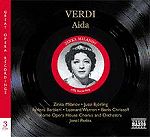 Amneris.
This recording has also had the benefit
of Mark Obert-Thorn’s remastering art
and is particularly vibrant (Review).
Although Milanov lacks Callas’s capacity
for characterisation her steadiness
and dramatic singing are preferable
to her rival’s rather underpowered and
manufactured approach again remastered
for Naxos by Mark Obert-Thorn (Review).
Both the Milanov and the Callas performances
were recorded in 1955. By that time
Callas no longer sang the role on stage.
One of her last stage performances of
the role of Aida was at Covent Garden
in 1953 under Barbirolli. Some critics
prefer Callas’s portrayal in this performance
to her studio recording (Testament SBT2
1355).
Amneris.
This recording has also had the benefit
of Mark Obert-Thorn’s remastering art
and is particularly vibrant (Review).
Although Milanov lacks Callas’s capacity
for characterisation her steadiness
and dramatic singing are preferable
to her rival’s rather underpowered and
manufactured approach again remastered
for Naxos by Mark Obert-Thorn (Review).
Both the Milanov and the Callas performances
were recorded in 1955. By that time
Callas no longer sang the role on stage.
One of her last stage performances of
the role of Aida was at Covent Garden
in 1953 under Barbirolli. Some critics
prefer Callas’s portrayal in this performance
to her studio recording (Testament SBT2
1355).
Decca with their excellent
engineers were quick off the mark with
stereo recordings. With Karajan as conductor
they reprised Tebaldi’s Aida in 1959
with the Vienna Philharmonic Orchestra
and State Opera Chorus in what was to
become one of their favourite recording
venues, Vienna’s Sofiensaal. With production
by John Culshaw and using a six channel
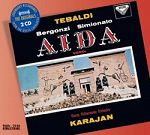 mixing
desk, with facility to expand to eighteen,
this recording was for some time a benchmark
for Aida recordings. Karajan
luxuriates in Verdi’s music in the triumphal
scene. The young Carlo Bergonzi is the
epitome of vocal grace as Radames and
Giulietta Simionato a fine Amneris.
(Decca 460 978-2 reissued 4758240).
John Culshaw must have been mightily
impressed by the young black American
Leontyne Price, then making waves in
Europe, to build a recording
mixing
desk, with facility to expand to eighteen,
this recording was for some time a benchmark
for Aida recordings. Karajan
luxuriates in Verdi’s music in the triumphal
scene. The young Carlo Bergonzi is the
epitome of vocal grace as Radames and
Giulietta Simionato a fine Amneris.
(Decca 460 978-2 reissued 4758240).
John Culshaw must have been mightily
impressed by the young black American
Leontyne Price, then making waves in
Europe, to build a recording 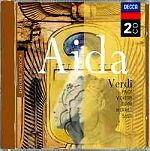 round
her in association with RCA a mere three
years later. Made in Rome her portrayal
of Aida on this recording, where she
is accompanied by the rather over-virile
singing of Jon Vickers as Radames, is
one of the finest portrayals of the
role on record. Solti is not the ideal
Verdian but with his dramatic drive
allied to sound stunning for its time
it wears well (Decca 460 765-2). RCA
tried a reprise of Price’s Aida ten
years later for issue to celebrate the
first performance in Cairo. Made in
London in July 1970 with a mouth-watering
cast including Grace Bumbry as Amneris
and the young Placido Domingo as a more
tastefully heroic Radames than Vickers,
it should have been a competitor to
Karajan’s first recording. Regrettably,
by the late 1960s RCA no longer had
the benefit of Decca’s engineers and
the recording was poor with obvious
drop-outs among its failures when issued
on LP. The CD issue has smoothed out
some deficiencies but its sonic limitations
still represent a glorious opportunity
lost (GD 74321 39498-2)
round
her in association with RCA a mere three
years later. Made in Rome her portrayal
of Aida on this recording, where she
is accompanied by the rather over-virile
singing of Jon Vickers as Radames, is
one of the finest portrayals of the
role on record. Solti is not the ideal
Verdian but with his dramatic drive
allied to sound stunning for its time
it wears well (Decca 460 765-2). RCA
tried a reprise of Price’s Aida ten
years later for issue to celebrate the
first performance in Cairo. Made in
London in July 1970 with a mouth-watering
cast including Grace Bumbry as Amneris
and the young Placido Domingo as a more
tastefully heroic Radames than Vickers,
it should have been a competitor to
Karajan’s first recording. Regrettably,
by the late 1960s RCA no longer had
the benefit of Decca’s engineers and
the recording was poor with obvious
drop-outs among its failures when issued
on LP. The CD issue has smoothed out
some deficiencies but its sonic limitations
still represent a glorious opportunity
lost (GD 74321 39498-2)
After an ill-fated
attempt with Corelli and Nilsson (358
654 at bargain price) EMI had more success
with Karajan’s second recording made
in conjunction with performances at
the Salzburg Festival .The conductor’s
tempi are idiosyncratically slow in
parts and his more lyrical view is matched
by the casting of the lightish voices
of Mirella Freni and José Carreras
in the lead roles (0777 769300 2). EMI
returned to the competitive fray ten
years later with Riccardo Muti’s ‘all
star’ first opera recording for the
company. The sound on the original 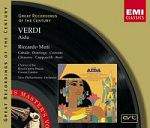 LPs
was compromised by efforts at ambisonics
but the CD has greater clarity in its
GROC reissue. With Montserrat Caballé
as Aida, Domingo as Radames and Fiorenza
Cossotto, Pierro Cappuccilli and Nicolai
Ghiaurov also present it is one of the
better sung recordings
(Review).
Domingo features on Abbado’s 1982 La
Scala recording, but with Ricciarelli
stretched as Aida and Elena Obraztsova
seriously miscast as Amneris, all in
a woolly acoustic. This is best avoided
(DG 410 092-2). Domingo appears yet
again for Sony alongside Aprile Millo
as Aida under Levine. The recorded sound
does no favours nor does the wooden
Amonasro of James Morris. Pavarotti
fans are best served by one of his performances
caught on DVD rather than on the CD
of his 1985 La Scala rendition under
Lorin Maazel’s unidiomatic baton. Maria
Chiara sings an appealing Aida although
a little past her best in a role she
sang regularly at Verona (Decca 417
439-2).
LPs
was compromised by efforts at ambisonics
but the CD has greater clarity in its
GROC reissue. With Montserrat Caballé
as Aida, Domingo as Radames and Fiorenza
Cossotto, Pierro Cappuccilli and Nicolai
Ghiaurov also present it is one of the
better sung recordings
(Review).
Domingo features on Abbado’s 1982 La
Scala recording, but with Ricciarelli
stretched as Aida and Elena Obraztsova
seriously miscast as Amneris, all in
a woolly acoustic. This is best avoided
(DG 410 092-2). Domingo appears yet
again for Sony alongside Aprile Millo
as Aida under Levine. The recorded sound
does no favours nor does the wooden
Amonasro of James Morris. Pavarotti
fans are best served by one of his performances
caught on DVD rather than on the CD
of his 1985 La Scala rendition under
Lorin Maazel’s unidiomatic baton. Maria
Chiara sings an appealing Aida although
a little past her best in a role she
sang regularly at Verona (Decca 417
439-2).
The pageantry of Aida
makes it a dream for any opera stage
with the necessary financial resources
and there are many versions on DVD.
The pageantry makes a big impact at
the Verona Arena although the more intimate
scenes are less well served. Catching
the dynamism of the orchestra and chorus
is also problematic. A 1982 performance
has Nicola Martinucci an upright Radames
and Maria Chiara an appealing Aida under
Anton Guadagno. A 1992 performance with
sets reconstructed from Mariette’s
designs for the arena has Maria
Chiara well past her best. Kristan Jöhannasson
as Radames lacks any Italianata and
the sound is unduly harsh (Review).
Pavarotti fans are well served by three
DVD recordings of a role he did not
sing that often on stage. The1985 La
Scala performance under Maazel is the
same as 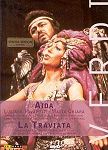 the
CD (Review).
In my view he is better caught alongside
the lyric and silver-voiced Aida of
Margaret Price in Sam Wanamaker’s production
recorded at the War Memorial Opera House,
San Francisco in 1981 with Garcia Navarro
on the rostrum (Review).
Alongside that Pavarotti performance
a personal favourite is the 1989 recording
from the Met conducted by James Levine.
Backed by a generous endowment to supplement
the house budget the staging is opulent.
Add the casting of Domingo, Aprile Millo
as Aida and Dolora Zajick as Amneris
sparking off each other and Sherrill
Milnes as Amonasro, this is as good
a theatre production as one is likely
to get. The Met audience are rather
too enthusiastic at times and the curtain
calls are repetitive (DG 073 001-9 GH).
For those allergic to such shows of
opulence and pageantry the antithesis
is found in Robert Wilson’s minimalist
staging. Intimate scenes involve the
singers not making eye contact as they
circle each other with hand movements
representing their emotions, or that
is what I think is being represented.
The set for the Nile Scene is visually
effective whilst that for the Tomb Scene
has resemblances of realism to go alongside
the Wilson’s minimalism
(Review).
the
CD (Review).
In my view he is better caught alongside
the lyric and silver-voiced Aida of
Margaret Price in Sam Wanamaker’s production
recorded at the War Memorial Opera House,
San Francisco in 1981 with Garcia Navarro
on the rostrum (Review).
Alongside that Pavarotti performance
a personal favourite is the 1989 recording
from the Met conducted by James Levine.
Backed by a generous endowment to supplement
the house budget the staging is opulent.
Add the casting of Domingo, Aprile Millo
as Aida and Dolora Zajick as Amneris
sparking off each other and Sherrill
Milnes as Amonasro, this is as good
a theatre production as one is likely
to get. The Met audience are rather
too enthusiastic at times and the curtain
calls are repetitive (DG 073 001-9 GH).
For those allergic to such shows of
opulence and pageantry the antithesis
is found in Robert Wilson’s minimalist
staging. Intimate scenes involve the
singers not making eye contact as they
circle each other with hand movements
representing their emotions, or that
is what I think is being represented.
The set for the Nile Scene is visually
effective whilst that for the Tomb Scene
has resemblances of realism to go alongside
the Wilson’s minimalism
(Review).
Outside the narrow
confines of the world of opera, 1870
and 1871 were momentous years in Europe
and had a direct impact on the staging
of Aida as I have shown. As Verdi
worked on the libretto of Aida,
Pio Nono, the longest ever serving Pope,
proclaimed the dogma of Papal Infallibility
at the 20th Vatican Council
on 18 July 1870. The next day France,
protector of Papal Rome, egged on by
Bismarck, declared war on Prussia over
the possibility of a German prince acceding
to the Spanish throne. In the first
week of August German soldiers crossed
into France and Napoleon III withdrew
the French army from Rome to help defend
the homeland. To protect what was left
of the independent Papal States Pio
Nono had only his own thirteen thousand
men. On 2 September the French army
was humiliated at Sedan and with Napoleon
himself captured the Second Empire fell
and the Third Republic was proclaimed.
The first siege of Paris by the Prussians
began on 19 September. On the same day
Italy’s Victor Emmanuelle seized his
chance and despatched troops to occupy
Rome, the oldest sovereignty in Europe,
in the name of the Italian State. The
Pope retired to the Vatican’s restricted
confines with much prayer and ceremony.
The ceremony included ascending the
Santa Scala on his knees whilst blessing
his troops; it was the last act of a
Pope in Papal Rome. The resultant Concordat
gave the Vatican, the Patrimony of St.
Peter, the independent diplomatic status
that it enjoys in the present day.
As I have noted Verdi’s
composition of Aida was complete
and the score ready for delivery in
November 1870, for its scheduled premiere
in Cairo in January 1871 and performances
at La Scala later the same month. With
the Cairo sets held in Paris by the
siege Verdi agreed to postpone both
productions. The Republican government
in France moved out of Paris to Versailles
as the Parisians choked on Bismarck’s
demand that his troops parade down the
Champs-Elysées. The Paris commune
resisted its new Government with rioting
and burning including the Tuileries.
The city was put under another siege,
this time by thirteen thousand French
troops who re-took it with much loss
of life among the Communards. At last
the Aida scenery could proceed
to Cairo and the production could also
go ahead at La Scala. With Italy unified,
except for Trieste and its region, and
with Rome as is capital and France in
disarray, Europe and its personnel were
changing faster than ever before.
In the year of Rossini’s
death in 1868, aided by arrangements
connived at by his wife and long-time
friend Clarina Maffei, Verdi had visited
his idol, Alessandro Manzoni. When Manzoni
died in May 1873, after a fall, Verdi
was devastated to the extent he could
not go to the funeral for which the
shops of Milan were closed, and the
streets lined with thousands. The King
sent two Princes of the Royal Blood
to carry the flanking cords and they
were aided by the Presidents of the
Senate and Chamber as well as the Ministers
of Education and Foreign Affairs. A
week after the funeral Verdi went to
Milan and visited the grave alone. 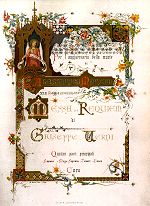 Then,
through his publisher, Ricordi, he proposed
to the Mayor of Milan that he should
write a Requiem Mass to
honour Manzoni to be performed in Milan
on the first anniversary of the writer’s
death. Unlike his proposal for a Requiem
to honour Rossini in 1868, there would
be no committee this time. Verdi proposed
that he himself would compose the entire
Mass, pay the expenses of preparing
and printing the music, specify the
church for the first performance, choose
the singers and the Requiem would
belong to Verdi. The city of Milan accepted
with alacrity.
Then,
through his publisher, Ricordi, he proposed
to the Mayor of Milan that he should
write a Requiem Mass to
honour Manzoni to be performed in Milan
on the first anniversary of the writer’s
death. Unlike his proposal for a Requiem
to honour Rossini in 1868, there would
be no committee this time. Verdi proposed
that he himself would compose the entire
Mass, pay the expenses of preparing
and printing the music, specify the
church for the first performance, choose
the singers and the Requiem would
belong to Verdi. The city of Milan accepted
with alacrity.
Verdi began work on
his Requiem in Paris in the summer
of 1873. It was his first visit to the
city since the days of the Commune and
the ruins of the Tuileries and other
burnt-out buildings saddened him. With
artistic unity guaranteed by the single
composer model, Verdi intended his Requiem
to have a regular place in the repertoire
just like his operas and other works.
Although he had already composed a Libera
Me for the aborted Rossini Requiem,
Verdi largely re-wrote it, thus ensuring
greater compositional coherence than
might otherwise have been the case.
He selected the Church of San Marco
for the premiere, considering it to
have the best proportions and acoustics.
On 22 May 1874, the first anniversary
of Manzoni’s death, with an orchestra
of one hundred and a chorus of one hundred
and twenty it was given to acclaim.
Three days later Verdi conducted another
performance at La Scala. This was followed
by two more conducted by Faccio. Argument
raged that Verdi, although using the
ecclesiastical text, had not written
music of that oeuvre. The work is certainly
not in the tradition of ecclesiastical
works set to counterpoint and fugues,
a fact that at least some purists considered
did not detract the listener from the
religious message. Despite criticisms
of this nature the Requiem travelled
to Paris where Verdi was made a Commander
of the Legion of Honour. After Paris,
London and Vienna followed with the
work acclaimed in each.
Some cynics have referred
to the Manzoni Requiem, as the
work is sometimes called, as being Verdi’s
best opera! After the reverential and
ecclesiastical style of the opening
Requiem and Kyrie the music varies between
the beautifully lyric and the heavily
dramatic as in the Dies irae
and Tuba mirum. At least stereo
is a minimum requirement for listening
to this work and I pass over some worthy
mono recordings. At its premiere the
soloists were renowned opera singers
and ever since it is conductors and
singers with that background who bring
out its strengths, both spiritual and
vocal. There is no shortage of both
CD and DVD recordings of the work. On
CD, EMI’s 1959 recording by the
veteran Tulio Serafin 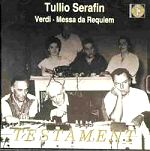 featuring
the Lebanese soprano Shakeh Vartenissian,
a young Fiorenza Cossotto singing vibrantly
alongside the tenor Eugene Fernandi
and Boris Christoff, who sings a redoubtable
Mors stupebit, has long been
a favourite of mine (Testament SBT 2140).
Others favour the 1963 recording conducted
by Giulini over that of his elder compatriot,
but with an English chorus not matching
its Italian counterparts and the lack
of Italianata in Schwarzkopf’s and Gedda’s
interpretations it is not a view I share
(EMI GROC). Solti’s very operatic interpretation
of 1967 for Decca with Joan Sutherland
and Marilyn Horne alongside the Finnish
bass Martti Talvela and the young Pavarotti
has its fans. Recorded in the Sofiensaal
Vienna it has more than a touch of dramatic
Wagner about it. If not exactly Italianate
it is sonically exciting (Decca 311
944-2). In the following three decades
pretty well every conductor of note
joined in with his chosen, or company-contracted,
soloists. The 1987 Telarc recording
with relatively less well-known soloists
is admired for its recording quality
and choral singing (Telarc CD 80152).
Riccardo Muti’s recording of the same
year, his second, features an all-star
American trio of Cheryl Studer, Dolora
Zajick, and Samuel Ramey alongside the
Italian Pavarotti and the chorus and
orchestra of La Scala, Milan. It has
all the frisson of a live performance
with Pavarotti’s singing of the Ingemisco
a highlight, but the acoustic of the
La Scala theatre is a problem for me
(EMI CDS 7 49390-2). More recently Gergiev’s
account with Kirov forces features the
superb female duo of Renée Fleming
and Olga Borodina set alongside the
unacceptable tenor singing of Andrea
Boccelli (Philips 468 079-2). Both Karajan
with two versions and Abbado, a natural
Verdian, have recordings on CD from
DG. Abbado’s fully digital version features
Cheryl Studer, Mariana Lipovsek, José
Carreras and Ruggero Raimondi backed
by the Vienna State Opera Chorus and
the Vienna Philharmonic (435 884-2).
Despite its sonic virtues it does not
replace earlier versions among my favourites.
A bargain-priced Decca Originals double
CD, has the young Leontyne Price and
Jussi Björling in The Requiem,
conducted by Fritz Reiner alongside
Verdi’s later Four Sacred Pieces
conducted by Mehta (467 119-2).
featuring
the Lebanese soprano Shakeh Vartenissian,
a young Fiorenza Cossotto singing vibrantly
alongside the tenor Eugene Fernandi
and Boris Christoff, who sings a redoubtable
Mors stupebit, has long been
a favourite of mine (Testament SBT 2140).
Others favour the 1963 recording conducted
by Giulini over that of his elder compatriot,
but with an English chorus not matching
its Italian counterparts and the lack
of Italianata in Schwarzkopf’s and Gedda’s
interpretations it is not a view I share
(EMI GROC). Solti’s very operatic interpretation
of 1967 for Decca with Joan Sutherland
and Marilyn Horne alongside the Finnish
bass Martti Talvela and the young Pavarotti
has its fans. Recorded in the Sofiensaal
Vienna it has more than a touch of dramatic
Wagner about it. If not exactly Italianate
it is sonically exciting (Decca 311
944-2). In the following three decades
pretty well every conductor of note
joined in with his chosen, or company-contracted,
soloists. The 1987 Telarc recording
with relatively less well-known soloists
is admired for its recording quality
and choral singing (Telarc CD 80152).
Riccardo Muti’s recording of the same
year, his second, features an all-star
American trio of Cheryl Studer, Dolora
Zajick, and Samuel Ramey alongside the
Italian Pavarotti and the chorus and
orchestra of La Scala, Milan. It has
all the frisson of a live performance
with Pavarotti’s singing of the Ingemisco
a highlight, but the acoustic of the
La Scala theatre is a problem for me
(EMI CDS 7 49390-2). More recently Gergiev’s
account with Kirov forces features the
superb female duo of Renée Fleming
and Olga Borodina set alongside the
unacceptable tenor singing of Andrea
Boccelli (Philips 468 079-2). Both Karajan
with two versions and Abbado, a natural
Verdian, have recordings on CD from
DG. Abbado’s fully digital version features
Cheryl Studer, Mariana Lipovsek, José
Carreras and Ruggero Raimondi backed
by the Vienna State Opera Chorus and
the Vienna Philharmonic (435 884-2).
Despite its sonic virtues it does not
replace earlier versions among my favourites.
A bargain-priced Decca Originals double
CD, has the young Leontyne Price and
Jussi Björling in The Requiem,
conducted by Fritz Reiner alongside
Verdi’s later Four Sacred Pieces
conducted by Mehta (467 119-2).
There is no shortage
of DVD rivals in this music with
Abbado’s name as conductor featuring
regularly. His most recent recording,
from the Berlin centenary anniversary
of Verdi’s death, features the Berlin
Philharmonic, the Swedish Radio Choir
and Chamber Choir. With the Rossini
mezzo Daniela Barcellona and the conductor
the only Italians around it lacks any
natural feel and the solo singing of
Alagna is a particular trial (EMI 9269-
9 and also on CD 557168-2)). I suspect
Abbado’s earlier recordings including
that from the Edinburgh Festival featuring
Margaret Price, Jessye Norman, Jose
Carreras and Ruggero Raimondi (Arthaus
100 146) and another with Montserrat
Caballé and Lucia Valentini-Terrani
are far better sung although I have
only seen the latter advertised on the
web as Region 1. Whilst I was 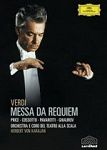 impressed
by near-veteran Zubin Mehta’s 2005 live
recording from the Santa Cecilia, Rome
(Review),
my personal favourite remains Karajan’s
La Scala performance of January 1967
with an unsurpassed quartet of Leontyne
Price, Fiorenza Cossotto, Luciano Pavarotti
and Nicolai Ghiaurov (DG 00440 073 4055
GH).
impressed
by near-veteran Zubin Mehta’s 2005 live
recording from the Santa Cecilia, Rome
(Review),
my personal favourite remains Karajan’s
La Scala performance of January 1967
with an unsurpassed quartet of Leontyne
Price, Fiorenza Cossotto, Luciano Pavarotti
and Nicolai Ghiaurov (DG 00440 073 4055
GH).
Section
4. The revised Simon Boccanegra
of 1881, Otello and Falstaff.
The years after the
composition of the Requiem were
the most arid of Verdi’s compositional
life. He was not idle. He travelled
widely conducting it and other of his
works and received many honours whilst
always complaining about the musical
standards in Italy. As the 1870s drew
to a close he had not composed an opera
since Aida at the end of 1870.
As he approached his seventies he was
in good health, but with his librettists
Piave and Solera dead, and Du Locle
weary of trying, nobody was stimulating
him with ideas. His publisher, Ricordi
tried nudging him towards a revision
of Simon Boccanegra for which
Verdi maintained a fondness despite
its chequered career, believing its
plot and music deserved a better fate
than neglect. Ricordi went to the extent
of sending Verdi a full score of the
original but the parcel remained unopened.
In early 1879, for
his own amusement, Verdi returned to
composition with a Pater Noster
for unaccompanied five part chorus,
and an Ave Maria for solo
soprano and string orchestra. His long-time
friend, Countess Maffei, based in Milan,
chided him about another opera to which
he responded that the account is
settled. In her salon the literati
of the city including Ricordi, the conductor
Faccio and Boito, composer, writer and
librettist, met regularly. Somewhere
among this group a plot seems to have
been hatched to get Verdi to write another
opera based on a Shakespeare play. In
the summer of 1879 the composer and
his wife went to Milan for him to conduct
a benefit concert of his Requiem
at La Scala on behalf of flood victims
in the Po valley. The soprano Teresa
Stoltz and mezzo Maria Waldmann came
out of retirement to sing. The concert
was a huge success artistically and
financially. A few days later the Verdis
invited Ricordi and Faccio to dinner.
The visitors turned the conversation
to an opera by Verdi, on a Shakespearian
theme with a libretto by Boito. Verdi
agreed to meet Boito the next day and
three days later received a scenario
from him of an opera based on Otello.
This was pretty quick work and points
to some earlier preparation. Verdi liked
Boito’s scenario and encouraged him
to put it into verse with the comment
it will always be good for you, for
me, or for someone else. Ricordi
encouraged Boito to do so and it was,
for some time, called the chocolate
scheme with Verdi insisting on the
utmost secrecy lest he felt pressured
in any way. Because of these fears he
deterred Ricordi from bringing Boito
on his visit to Sant’ Agata fearing
it would promote rumours of another
opera. He had, however, encouraged Ricordi
to send him Boito’s versified version
to read at his leisure. Most importantly
Verdi’s mind was on opera and composition
in a manner it had not been for several
years. Ricordi’s visit had followed
that of the Director of the Paris Opéra
to whom Verdi promised a revised Aida,
in French and with ballet, for the following
year. After Ricordi left, somewhat disappointed,
Giuseppina wrote to him, behind her
husband’s back, advising him to be patient
and that they would be in Milan later
when a visit by Boito would hardly be
noticed. Although pathologically fearing
the secret would leak, and while not
committing himself, Verdi secretly began
looking at costumes and pictures, trying
to visualise the characters and setting
in his own mind whilst in public he
seemed occupied with other matters.
The other matters on
Verdi’s mind included the French version
of Aida and he went to Paris
to supervise rehearsals. The French
Aida was premiered at the Opéra
on 22 March 1880 to great acclaim, stirring
up jealousies in some native composers.
Back in Milan in April the composer
heard his Ave Maria and Pater
Noster conducted by Franco Faccio
at La Scala where a statue of him was
unveiled in the foyer where it remains
to this day. Afterwards he returned
to Sant’ Agata without any further commitment
to the chocolate scheme although
he had asked Boito for some revisions
of the verses for act 3. Ricordi could
see no sign of work being done and again
suggested a visit accompanied by Boito.
Giuseppina warned him away with the
words Verdi has not yet, despite
the very good verses, got his ideas
clear, and without clear ideas he will
decide now, or at any rate later, never
to compose… it is better to leave things,
at least for the moment, just as they
are, wrapping the Moor in as great a
silence as possible. Ricordi wisely
followed her advice and dropped talking
to the composer about Otello
and switched back to the idea of a revision
of Simon Boccanegra. Verdi’s
regard for this work, and he was his
own sternest critic, meant that although
it had fallen into neglect, the possibility
of revision and revival was never far
from his mind and he responded that
he was prepared to begin work at once
if a suitable librettist could be found.
Ricordi persuaded Boito, who was not
initially enthusiastic, to take on Piave’s
rambling plot and verses. Working alongside
Verdi, Boito soon warmed to his task,
pressing the composer to set an entire
new act in the church of San Siro. Verdi
did not want to compose an entire new
act and the two settled on an earlier
idea of a new scene set in the Council
Chamber. Stimulated by his librettist’s
grasp of the local colour of Genoa,
where the Verdi’s lived each winter,
the composer undertook more revisions
of the original score than he had at
first intended. He worked on the score
throughout January 1881 in Genoa, leaving
on 24 February for Milan to supervise
rehearsals. The baritone Victor Maurel,
who had been the Amonasro in the Paris
Aida, took the title role with
Francesco Tamagno singing Gabriele Adorno.
The first night at La Scala on 21 March
1881 was a triumph, with ten performances
being given in the season. Boito, however,
told Ricordi that he attributed no
artistic or literary merit to the
revisions of poor Piave’s verses and
insisted that neither his name nor his
anagram should appear on the programme!
The Council Chamber
scene of the revised Simon Boccanegra
is one of the mature Verdi’s most dramatic
musical creations. With its seamless
unfolding of the drama its music is
clearly a very a near relative of that
in Otello. Its drama contrasts
sharply with the first scene with its
quiet E major chords that are so evocative
of the sea and flowing tides and that
which precedes Amelia’s Come in quest’ora
bruna. They reflect Verdi’s intimate
knowledge of a town where he and his
wife spent most winters and owned an
apartment. As well as the addition of
the Council Chamber scene there are
many other differences between the 1880
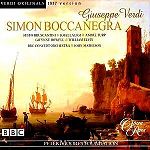 revision
and the 1857 original that make comparisons
fascinating for Verdi enthusiasts. The
Opera Rara recording of the original
1857 version allows for such captivating
comparisons (Review).
It is dealt with in its compositional
sequence as Verdi’s 21st
opera . What is manifestly true is that
the twenty-four years between the original
Boccanegra and the revision show
less of the stylistic discontinuity
found in the two versions of Macbeth
divided by a mere eighteen years. This
reflects Verdi’s compositional maturity
at the time of the original which followed
the great middle period trio of Rigoletto,
Trovatore and Traviata.
revision
and the 1857 original that make comparisons
fascinating for Verdi enthusiasts. The
Opera Rara recording of the original
1857 version allows for such captivating
comparisons (Review).
It is dealt with in its compositional
sequence as Verdi’s 21st
opera . What is manifestly true is that
the twenty-four years between the original
Boccanegra and the revision show
less of the stylistic discontinuity
found in the two versions of Macbeth
divided by a mere eighteen years. This
reflects Verdi’s compositional maturity
at the time of the original which followed
the great middle period trio of Rigoletto,
Trovatore and Traviata.
In the present-time
stage performances of Simon Boccanegra
are not frequent nor are recordings.
With very few exceptions both are of
the1881-revised version under consideration
here. In 1954 HMV had broken new ground
with its Rome recording of Don Carlo
with Gobbi and Christoff under Santini,
the house musical director. The company
returned in 1958 with the same duo as
Boccanegra and Fiesco respectively to
record the revised version of
Simon Boccanegra. With Victoria
de los Angeles an appealing Amelia and
Giuseppe Campora not over-parted as
Gabriele Adorno it set a standard that
took some years to equal. Tito Gobbi’s
Boccanegra stands alongside his Rigoletto
and Iago as one of the definitive recorded
Verdi interpretations of all time and
is matched by Christoff’s implacable
Fiesco. Unaccountably it was not recorded
in stereo, which the company had used
for Karajan’s Falstaff in June
1956! (Review
Falstaff ). This HMV recording tended
to overshadow the Cetra issue derived
from Radio Italiana broadcast from Rome
with Paolo Silveri in the title role,
Antoinetta Stella as Amelia and the
young Bergonzi as Adorno (Warner Fonit
8573 82648-2) A first stereo recording
came from RCA in 1974 with Pierro Cappuccilli
in the title role, Katia Ricciarelli
as Amelia and Ruggero Raimondi. Placido
Domingo’s virile Adorno and its stereo
recording are the main virtues. But
then, as with Macbeth a year
earlier, DG was on the spot in Milan
to record another Verdi opera following
another of Giorgio Strehler’s outstanding
and acclaimed productions at La Scala
under Abbado. As with the earlier Macbeth
the theatre was again unavailable for
recording during the performing season,
so in January 1977 DG again used the
Centro Telicinematografica Culturale
with its warm but sympathetic acoustic
for its recording of Simon Boccanegra.
Whilst not one of nature’s outstanding
vocal characterisers, but with the proximity
of the theatre production and Abbado’s
direction, Pierro Cappuccilli gives
an altogether more involved and better
characterised performance than he had
for RCA three years earlier. Whilst
not erasing memories of Tito Gobbi’s
dramatic singing in the earlier EMI
recording of the Council Chamber scene,
Cappuccilli’s rendition in this scene
is noteworthy. 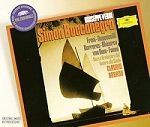 Ghiaurov
is rock solid and vocally expressive
as Fiesco, Mirella Freni well cast as
Amelia and the young Carreras vibrant
as Adorno. This recording, now on two
mid-price CDs has deservedly dominated
the market in this opera (DG Originals
449 752-2). Decca recorded the work
in the Sala Abanella, Milan in December
1988 under Solti. Except for Kiri Te
Kanawa’s Amelia it is undistinguished
(Review).
After the Decca recording, audio versions
seemed to dry up until a live performance
from the New Zealand Festival in 2000
appeared. With the added frisson of
a live occasion allied to a strong portrayal
of the title role and well-recorded
sound this latest recording has much
to commend it (Review).
Ghiaurov
is rock solid and vocally expressive
as Fiesco, Mirella Freni well cast as
Amelia and the young Carreras vibrant
as Adorno. This recording, now on two
mid-price CDs has deservedly dominated
the market in this opera (DG Originals
449 752-2). Decca recorded the work
in the Sala Abanella, Milan in December
1988 under Solti. Except for Kiri Te
Kanawa’s Amelia it is undistinguished
(Review).
After the Decca recording, audio versions
seemed to dry up until a live performance
from the New Zealand Festival in 2000
appeared. With the added frisson of
a live occasion allied to a strong portrayal
of the title role and well-recorded
sound this latest recording has much
to commend it (Review).
As far as DVD
is concerned if a recording exists of
the Strehler La Scala production it
would be welcomed with open arms. The
production was widely toured including
to London when every Italian in the
UK and Europe outside Milan seemed the
only people to be able to 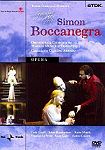 get
a ticket, the performances living up
to its reputation! Abbado’s more recent
conducting of Simon Boccanegra
is available on a performance featuring
Karita Mattila, Carlo Guelfi as the
Doge and Julian Konstantinov as Fiesco
(TDK OP SIBO). Mark Elder conducts Peter
Hall’s 1998 Glyndebourne production
with Elena Prokina a lovely Amelia in
a good all-round cast. Whilst the orchestral
playing is outstanding and the singing
is good, the production lacks some visual
and dramatic clarity (Review).
Visual clarity, with traditional stage
pictures, is the standard of Gian Carlo
del Monaco’s 1995 Met production. Vladimir
Chernov is a tonally and histrionically
strong Boccanegra and Te Kanawa an involved
Amelia with Robert Lloyd as Fiesco and
Domingo as Adorno in good vocal form.
James Levine conducts with taut involvement
(Review).
Peter Stein’s production, first seen
in Vienna in 2002, was recorded in Florence
in 2005. It features the American baritone
Thomas Hampson in the title role. He
gives one of his best Verdi interpretations
to date (Review).
If the other soloists do not quite manage
to match his virtues neither do they
let the side down. The generally sparse
sets contrast with that for the Council
Chamber scene.
get
a ticket, the performances living up
to its reputation! Abbado’s more recent
conducting of Simon Boccanegra
is available on a performance featuring
Karita Mattila, Carlo Guelfi as the
Doge and Julian Konstantinov as Fiesco
(TDK OP SIBO). Mark Elder conducts Peter
Hall’s 1998 Glyndebourne production
with Elena Prokina a lovely Amelia in
a good all-round cast. Whilst the orchestral
playing is outstanding and the singing
is good, the production lacks some visual
and dramatic clarity (Review).
Visual clarity, with traditional stage
pictures, is the standard of Gian Carlo
del Monaco’s 1995 Met production. Vladimir
Chernov is a tonally and histrionically
strong Boccanegra and Te Kanawa an involved
Amelia with Robert Lloyd as Fiesco and
Domingo as Adorno in good vocal form.
James Levine conducts with taut involvement
(Review).
Peter Stein’s production, first seen
in Vienna in 2002, was recorded in Florence
in 2005. It features the American baritone
Thomas Hampson in the title role. He
gives one of his best Verdi interpretations
to date (Review).
If the other soloists do not quite manage
to match his virtues neither do they
let the side down. The generally sparse
sets contrast with that for the Council
Chamber scene.
After the great success
of the revised Simon Boccanegra
at La Scala, Ricordi and Boito hoped
that Verdi would give a firm commitment
to the ‘chocolate scheme’, the
composition of Otello. Strepponi
had earlier warned Ricordi against putting
pressure on the composer whilst encouraging
him by saying that Verdi liked Boito’s
verses. Boito never discussed the matter
in public but the newspapers increasingly
talked about Boito’s Iago. Even Verdi
himself let comments slip as when he
commented to Victor Maurel on his singing
of Boccanegra with something like if
God gives me good health, I’ll write
Iago for you. But time passed and
Verdi seemed little inclined to make
the words binding. In 1883 he was seventy
and composition was still alive and
kicking in his psyche and he embarked
on the major revision of Don Carlo,
reducing it as earlier noted to four
acts. This version was premiered at
La Scala in January 1884. In reality
Verdi was encouraging Boito to make
changes in the libretto even though
he was reluctant to make a definite
commitment. He was knocked sideways
by the death of Wagner in 1883 at his
same age and then by the partner, husband
in all but name in a country with no
divorce, of his long time friend Countess
Maffei. As the great writer Victor Hugo
passed away in the same year Verdi must
have thought of his own Ernani
and Rigoletto based on the great
man’s work as well as his own mortality.
Garibaldi, crippled by arthritis and
seen by many as the father of Italy,
also passed on in that year. Verdi,
instead of elation at his own national
status and recognition was depressed,
even finding his fame a burden. But
after attending some of the rehearsals
at La Scala of the revised four act
Don Carlo, with its new music
in act 3 and other revisions, he returned
to Otello with more determination
although not with consistent application
as he and his wife travelled widely
to Expositions and for performances
of his works. Even the death of Countess
Maffei herself in July 1886 did not
shake his determination. As he hurried
to her bedside he perhaps remembered
her earlier chiding him about his not
having written a new opera for some
years.
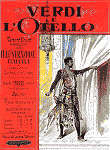 Verdi
finished the composition of Otello,
his 27th opera, in November
1886 and personally attended some rehearsals,
encouraging dramatic commitment and
conviction from the singers. Although
there are indications in the revised
Simon Boccanegra of an evolving,
more seamless, compositional style from
Verdi, with a definite move away from
the more static style of aria, duet
and chorus, Otello marks a major change.
As Budden (Verdi. Master Musicians
Series. Dent 1985) puts it; the composer
conceived it from the start in terms
of whole acts that proceed from start
to finish without interruption. The
drama moves by smooth transition from
one event to the next. In his conception
Verdi was greatly aided by Boito’s taut
libretto that reduced Shakespeare’s
‘Othello’ by six-sevenths but without
losing its essence of the destruction
of the erstwhile hero by the genie of
jealousy aided by the evil machinations
of Iago. Boito dispensed with Shakespeare’s
Venice act and focused the whole of
the action in Cyprus. Iago’s Credo
in act two is Boito’s invention.
Verdi
finished the composition of Otello,
his 27th opera, in November
1886 and personally attended some rehearsals,
encouraging dramatic commitment and
conviction from the singers. Although
there are indications in the revised
Simon Boccanegra of an evolving,
more seamless, compositional style from
Verdi, with a definite move away from
the more static style of aria, duet
and chorus, Otello marks a major change.
As Budden (Verdi. Master Musicians
Series. Dent 1985) puts it; the composer
conceived it from the start in terms
of whole acts that proceed from start
to finish without interruption. The
drama moves by smooth transition from
one event to the next. In his conception
Verdi was greatly aided by Boito’s taut
libretto that reduced Shakespeare’s
‘Othello’ by six-sevenths but without
losing its essence of the destruction
of the erstwhile hero by the genie of
jealousy aided by the evil machinations
of Iago. Boito dispensed with Shakespeare’s
Venice act and focused the whole of
the action in Cyprus. Iago’s Credo
in act two is Boito’s invention.
The more seamless compositional
style of Verdi’s Otello has always
appealed to musicians whilst the public
has been more equivocal. This may well
be due to lack of familiarity consequent
on the scarcity of performances as much
as formal arias. This scarcity of performances
is often due to Verdi’s vocal demands
on the tenor singing the title role.
To quote Budden again, the title
role in Otello lies well beyond the
scope of the average operatic tenor.
In reality the role is beyond some of
the greatest of tenors. Bergonzi had
no difficulty with either Radames in
Aida or Manrico in Il Trovatore,
but he only tried Otello once, in a
concert performance after his retirement
from the stage and his voice cracked
in the great act I outburst. Whilst
Manrico in Il Trovatore and Radames
in Aida can be sung by a strong-voiced
and full-toned lyric tenor with vocal
heft, the role of Otello calls for a
voice of more dramatic and heroic quality
not far short of that of a Wagnerian
Heldentenor. Awareness of this vocal
demand explains why Pavarotti as well
as Bergonzi never sang the role on stage.
Often tenors singing the role will have
a distinctly baritonal hue to the voice.
This is true on the recording conducted
by Toscanini who played in the string
section at the premiere, and which dominated
the first few years of the LP era. Ramon
Vinay was Toscanini’s choice and there
are times when he is not tonally too
far differentiated from the baritone
Iago. The recording of the 1947 live
broadcast emerged on LP from RCA in
1953 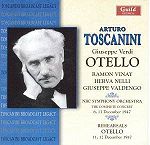 and
dominated the catalogue for the remainder
of the decade. The sound on the recording
has always been problematic and more
recently Richard Caniel, doyen of re-mastering
live Met broadcasts has produced a recording,
including Toscanini’s rehearsals, from
an alternative source, claiming superior
results (Review).
Vinay’s widely appreciated interpretation
of Otello also features on a live 1955
recording from London’s Covent Garden.
Rafael Kubelik’s conducting is not as
frenetic as Toscanini’s whilst Gré
Brouwenstijn’s Desdemona is superior
to her RCA counterpart (ROHS 001).
and
dominated the catalogue for the remainder
of the decade. The sound on the recording
has always been problematic and more
recently Richard Caniel, doyen of re-mastering
live Met broadcasts has produced a recording,
including Toscanini’s rehearsals, from
an alternative source, claiming superior
results (Review).
Vinay’s widely appreciated interpretation
of Otello also features on a live 1955
recording from London’s Covent Garden.
Rafael Kubelik’s conducting is not as
frenetic as Toscanini’s whilst Gré
Brouwenstijn’s Desdemona is superior
to her RCA counterpart (ROHS 001).
Towards the end of
the 1950s, John Culshaw at Decca, and
progenitor of the ‘First Recorded Ring
Cycle’ planned an aural Otello
spectacular. Built around Decca’s contracted
artists, the big-voiced tenor Mario
Del Monaco in the title, and the spinto
soprano Renata Tebaldi as Desdemona
and with Karajan conducting the Vienna
Philharmonic. It was recorded in the
company’s favourite Vienna venue. The
recording includes sound effects and
the full ballet that Verdi composed
for the Paris premiere in 1895 (Decca
440 245-2). What 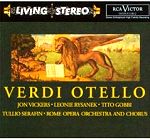 Culshaw
hadn’t bargained for was that a year
before his recording was issued in Autumn
1961, RCA would beat his male cast hands
down with the young Canadian Jon Vickers
as Otello and Tito Gobbi as Iago giving
one of his greatest recorded Verdi assumptions.
Serafin is truer to Verdi than Karajan,
whilst Tebaldi is more vocally appealing
than RCA’s Leonie Rysanek (09026 63180-2).
Culshaw
hadn’t bargained for was that a year
before his recording was issued in Autumn
1961, RCA would beat his male cast hands
down with the young Canadian Jon Vickers
as Otello and Tito Gobbi as Iago giving
one of his greatest recorded Verdi assumptions.
Serafin is truer to Verdi than Karajan,
whilst Tebaldi is more vocally appealing
than RCA’s Leonie Rysanek (09026 63180-2).
EMI stood off the recording
pace until rediscovering Barbirolli’s
operatic credentials with Madama
Butterfly recorded in Rome when
they assembled a cast for a London recording
in 1968. James McCracken in the name
part is adequate whilst Gwyneth Jones
is an unsteady Desdemona. More disastrously
is the casting of Fischer-Dieskau as
Iago. I well remember Barbirolli at,
a launch party, supported by his producer
Kinloch Anderson trying to justify this
casting. Following some mealy mouthed
contemporaneous support from critics
I was left with a played once set of
LPs! (EMI 565296). EMI were more successful
with Karajan’s second recording based
on his early 1970s production at Salzburg
with Vickers as Otello, Freni an appealing
Desdemona and Yorkshire-born Peter Glossop
an appropriately bluff Iago on one of
his too rare recorded assumptions (769398
2).
Even as Solti recorded
his studio Otello in 1977 featuring
Carlo Cossotto as a histrionically convincing,
but sometimes vocally uneven Moor, alongside
a radiant Margaret Price as a lyrical
Desdemona (Decca 460 756-2), the young
Placido Domingo was making waves as
Otello. It is a role that the singer
came to dominate in the theatre and
in audio and visual recordings for the
next 25 years. His first recorded assumption
was made in London’s Walthamstow Town
Hall in the summer of 1978 under James
Levine. Levine shows a real feel for
Verdi’s drama without any of the metronomic
brashness of his Giovanni D’Arco
for EMI a few years earlier. Although
some of the American contingent in the
lesser parts has weaknesses, the Ambrosian
Operas Chorus and the National Philharmonic
give excellent support. Sherrill Milnes
is a smooth-voiced Iago and Renata Scotto
the odd sour note apart, a characterful
Desdemona. Domingo’s second version
was made in association with a film
version directed by Franco Zeffirelli
and with Maazel a not particularly sympathetic
conductor. Domingo’s singing is darker
hued than on his RCA assumption. With
Justino Diaz a rather penny plain Iago
and Katia Ricciarelli heavy-toned as
Desdemona this performance has little
appeal for me (EMI 747450 8).
Still searching for
a modern and definitive recording of
Otello, Decca turned to their
contracted artists, podium supremo Georg
Solti and tenor Pavarotti, who had never
sang Otello on stage. The company arranged
to record concert performances in Chicago
and New York in April 1991 also featuring
Kiri Te Kanawa and Leo Nucci and backed
by the Chicago Symphony Orchestra and
Chorus. Pavarotti’s singing in the lyric
passages is enjoyable but his overall
assumption is shallow with the tenor
being unduly careful in the big declamatory
outbursts. Leo Nucci’s wiry Iago is
undistinguished whilst Te Kanawa’s rendering
of the long last act scene including
the Desdemona’s Ave Maria and Willow
Song is one of the best on record. (Decca
433 669-2). Solti and the Chicago forces
are also excellent as is the recording
despite the different venues. DG might
have tried to tempt Carlos Kleiber to
set down his interpretation in the mid-1980s
as he conducted widely admired performances
at Covent Garden and La Scala, but the
maestro was ever allergic to the studio.
In the end it was not difficult for
DG to ace their Decca rivals with Domingo’s
last studio recording idiomatically
conducted by Myung-Whun Chung and backed
by the forces of the Bastille Opera,
Paris, of which he was, for all too
brief a time, Musical Director. 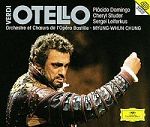 Domingo’s
interpretation and vocal characterisation
of the role in this 1993 performance
is consummate with his tone distinctly
darker hued than on his first recording
for RCA. Cheryl Studer is a firm toned
and effective Desdemona whilst the Russian
Sergei Leiferkus comes over as the epitome
of evil as Iago, albeit with caveats
regarding his rather glottal vocal production
and use of parlando (DG 439 805-2).
Domingo’s
interpretation and vocal characterisation
of the role in this 1993 performance
is consummate with his tone distinctly
darker hued than on his first recording
for RCA. Cheryl Studer is a firm toned
and effective Desdemona whilst the Russian
Sergei Leiferkus comes over as the epitome
of evil as Iago, albeit with caveats
regarding his rather glottal vocal production
and use of parlando (DG 439 805-2).
In my view, in none
of Placido Domingo’s currently available
commercial audio or video recordings
of the role of Otello do his fellow
artists wholly match him. However, many
of his stage and concert performances
were often the subject of audio broadcast
and these presumably exist on tape.
I have one such of a thrilling concert
performance conducted by Solti with
Domingo alongside Te Kanawa as Desdemona.
Arts Music has issued a recording of
Kleiber conducting the season’s opening
production at La Scala in December 1976
with Domingo alongside Cappuccilli and
Mirella Freni but at that stage the
tenor was very early in his command
of all the nuances of the role.
Placido Domingo’s portrayal
of Verdi’s Moor dominates the DVD
market. But his is not the only
interpretation of note. Jon Vickers’
is a considerable one and is caught
on the 1973 film based on the Salzburg
production, supervised and conducted
by Karajan, when the singer was in his
late forties. The sound was recorded
the previous December by the Berlin
Philharmonic and chorus of the Deutsche
Oper and dubbed on with the lip-sync
not always perfect, particularly in
some close-ups. Freni is an affecting
Desdemona and Peter Glossop a convincing
Iago. The film allows for some spectacular
effects not possible in the theatre
(Review).
A 1982 performance recorded at Verona
and admired by a colleague (Review)
has Vladimir Atlantov as a strong-voiced
but hardly sensitive Otello alongside
Te Kanawa and Cappuccilli under Zoltan
Pesko. I discount the DVD of the Zeffirelli
film. This has Domingo alongside a lovely
looking but vocally out of form Ricciarelli
and a dull Iago; Maazel conducts with
more drama than nuance. Domingo’s 1992
performance from Covent Garden alongside
Te Kanawa and Leiferkus conducted by
Solti with Brian Large in charge of
the video is much more balanced and
dramatic. It is justifiably well thought
off (BBC/Pioneer 425736). In his 1995
performances in Elijah Moshinsky’s production
at the Met in traditional lavish sets
by Michael Yeargan, Domingo is, as on
his first audio recording, working with
James Levine. The tenor is in imperious
voice as is Renée Fleming particularly
in act 4 where she acts well. Levine
is more variable and James Morris’s
Iago is less than wholly convincing
as a villain (DG 073 092-9GH). One of
Domingo’s best performances 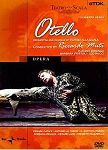 comes
from the December 2001 La Scala run
of Graham Vick’s production conducted
by Muti. Here he is alongside the well
thought out Desdemona of Barbara Frittoli,
with whom he sang at the Salzburg Easter
Festival in 1996. She hasn’t the refulgent
tone of Te Kanawa and Nucci’s Iago has
little virtue. (Review).
During his domination of the role on
stage Domingo came to be able to represent
the many facets of Otello’s character.
With his retirement from the role many
have taken the view that José
Cura was the most likely among the contemporary
tenors, to be his successor. However,
his 2006 performances at the Gran Teatre
del Liceu, in Willy Decker's quirky
production with sets by John Macfarlane,
indicates that he has a lot to learn.
Particularly he would seem to be in
need of a more orthodox staging and
the benefit of firm direction if he
is to follow in Domingo’s distinguished
footsteps (Review).
comes
from the December 2001 La Scala run
of Graham Vick’s production conducted
by Muti. Here he is alongside the well
thought out Desdemona of Barbara Frittoli,
with whom he sang at the Salzburg Easter
Festival in 1996. She hasn’t the refulgent
tone of Te Kanawa and Nucci’s Iago has
little virtue. (Review).
During his domination of the role on
stage Domingo came to be able to represent
the many facets of Otello’s character.
With his retirement from the role many
have taken the view that José
Cura was the most likely among the contemporary
tenors, to be his successor. However,
his 2006 performances at the Gran Teatre
del Liceu, in Willy Decker's quirky
production with sets by John Macfarlane,
indicates that he has a lot to learn.
Particularly he would seem to be in
need of a more orthodox staging and
the benefit of firm direction if he
is to follow in Domingo’s distinguished
footsteps (Review).
During the final period
of Otello’s
composition, Verdi made meticulous plans
for its premiere. This included visiting
Paris in March 1886 to check on the
vocal state of Victor Maurel about whom
he had heard conflicting reports. He
was reassured and happy that the baritone
would be his Iago. He completed the
orchestration of Otello during
October and the following month personally
undertook the coaching of Tomagno in
the title role with full rehearsals
starting in Milan in January; all very
demanding and tiring for a man in his
74th year. Whatever failings
there were on that first night on 5
February 1887 the reception was rapturous.
Verdi took over twenty curtain calls
after which a cheering crowd, who then
serenaded him for several hours, drew
his carriage back to his hotel. Three
days later Verdi was made an honorary
citizen of Milan.
The day after the premiere
of Otello Verdi excused himself,
for reason of tiredness, from a reception
given by Ricordi for celebrities, journalists
and critics. Verdi was not only tired
but also sad. In July his friend of
over forty years, Clara Maffei, died
in Milan. Verdi had interrupted his
holiday at Montecantini and rushed to
her bedside. It was she had cajoled
him to write more opera during the fallow
post-Aida years and it was in
her salon that Ricordi and Boito plotted
to tempt Verdi to compose more opera.
But Verdi was also sad that he now lacked
a goal. Before he left Milan the directors
of La Scala approached him about the
possibility of a comic opera. He replied
don’t you know how old I am and
professed his desire to return to his
country life at Sant’ Agata where Boito
visited him in November with a French
translation of Otello. Verdi
also concerned himself with the hospital
at Villanova he had built for his locality.
Despite having watched its construction
with care, and in typical fashion, he
refused to have his name inscribed over
the door. Meanwhile he kept his compositional
hand in with Laudi alla Vergine,
which was followed by Ave Maria scala
enigmata, his fourth setting of
an Ave Maria. Later, together
with the Te Deum and Stabat
Mater, each for chorus and orchestra,
these became constituents of what came
to be called The Four Sacred Pieces
(Quattro Pezzi Sacri).
The proposal for a
comic opera for La Scala niggled at
Verdi, but he worried about his age
and the possibility of starting another
opera and not finishing it. Boito was
aware of his feelings and also with
his love of Shakespeare’s ‘Merry Wives
of Windsor’. Whilst Verdi worried about
Boito completing his own opera Nerone,
the poet choosing his time well, sent
a synopsis to Verdi on his annual holiday
at Montecantini in July 1889. Verdi
responded enthusiastically only to express
doubts the following day, worrying that
another operatic composition might over-stretch
his strength. But those doubts were
not reflected in his invitation to Boito:
Come and see us. Boito assured
Verdi that writing a comic opera would
be less fatiguing than a tragedy concluding:
There is only one way to end your
career more splendidly than with ‘Otello’,
and that is to end it with ‘Falstaff’.
After returning to Sant’ Agata later
that July, Verdi began to make sketches
even before receiving any verses from
Boito.
In between the quick
start and Boito bringing the completed
acts 1 and 2 in November, Verdi digressed
to purchase a plot of land in Milan
to build a rest home for elderly and
indigent musicians and endow it with
an annual income. He later appointed
Boito’s brother as architect.
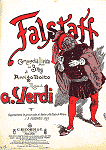 The
completion of Falstaff
his 28th and final opera,
proceeded more steadily than that of
Otello, but with Verdi doing
no more than two hours work a day on
it. For at least a year composer and
librettist kept the composition under
wraps with not even Ricordi in on the
secret. A couple of years after the
premiere of Otello Verdi wrote
to a friend What can I tell you?
I’ve wanted to write a comic opera for
forty years, and I’ve known ‘The Merry
Wives of Windsor’ for fifty… however,
the usual buts and I don’t know if I
will ever finish it…I am enjoying myself.
There were hiccups along the way but
the composition was finished by November
1892 with Falstaff being premiered
at La Scala on 9 February 1893. Verdi
was in his 80th year. He supervised
rehearsals and attended the first three
nights as was usual, taking many curtain
calls. It was rumoured that the government
intended to give him the title of Marquis
of Busseto. In abject horror Verdi wrote
to the Minister of Education who replied
that the rumour was groundless.
The
completion of Falstaff
his 28th and final opera,
proceeded more steadily than that of
Otello, but with Verdi doing
no more than two hours work a day on
it. For at least a year composer and
librettist kept the composition under
wraps with not even Ricordi in on the
secret. A couple of years after the
premiere of Otello Verdi wrote
to a friend What can I tell you?
I’ve wanted to write a comic opera for
forty years, and I’ve known ‘The Merry
Wives of Windsor’ for fifty… however,
the usual buts and I don’t know if I
will ever finish it…I am enjoying myself.
There were hiccups along the way but
the composition was finished by November
1892 with Falstaff being premiered
at La Scala on 9 February 1893. Verdi
was in his 80th year. He supervised
rehearsals and attended the first three
nights as was usual, taking many curtain
calls. It was rumoured that the government
intended to give him the title of Marquis
of Busseto. In abject horror Verdi wrote
to the Minister of Education who replied
that the rumour was groundless.
Whilst Boito had reduced
Shakespeare’s ‘Othello’ by six-sevenths,
for Falstaff he reduced the 23
characters in ‘The Merry Wives of
Windsor’ to just ten in the opera.
The vocal score does not designate primo
or secondo for these characters, but
it is clear that six carry the burden
of the singing and the plot. The others
require vocal competence in the idiom
if the reality of the comedy of ‘Falstaff’
is to be fully realised, none more so
than in recordings. In Falstaff
with the wit being in the words, Verdi
caries the seamless musical style of
Otello even further. There are
almost no formal arias and no recitative,
the melodic phrases being insistent
to give an almost continuous melodic
line; tunes come and go in the flash
of a few bars, broken only for ensembles.
In a letter to her sister Strepponi
described it as a new combination
of poetry and music.
Verdi composed the
role of Falstaff with Victor Maurel
in mind. However, the casting for any
performance whilst being paramount might
more accurately be considered merely
primus inter pares. On record
the early LP era was, as with Otello,
dominated by a mono live performance
conducted by Toscanini, then 84, with
Giuseppe Valdengo in the title role
(RCA 74321). Depending on your enthusiasm
for the maestro it is hard driven or
full of sparkle. What it certainly did
was overshadow the Cetra recording under
Rossi made in 1949 and with an all-Italian
cast. Taddei as Falstaff has the ideal
fruity tone for the role with the interplay
of the others in their native language
a thing to marvel at (Warner Fonit 8573
82710-2). Then along came EMI with one
of, if not the, earliest, stereo recordings
of opera. 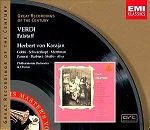 Featuring
Tito Gobbi in the title role and Rolando
Panerai as Ford it has been a dominant
presence in the catalogue to the present
day through many price bands. Currently
it is available in the EMI Great
Recordings of the Century series
or at budget price without libretto
(Review).
Although Gobbi lacks the perfect Falstaff
voice he is abundantly aware of every
nuance and gives an outstanding interpretation.
Apart from Schwarzkopf, who lacks some
Italianata, the ladies articulate their
laughter superbly with Barbieri’s low-toned
reverenzas being rarely bettered.
The young Anna Moffo and Luigi Alva
are a fine pair of lovers. Next up were
RCA in 1963. Conducted by Solti, with
engineers on loan from Decca, and Welshman
Geraint Evans in the title role matching
Gobbi for nuance but with more colour
to his tone, it was an immediate rival
to Karajan. Robert Merrill is a strong
voiced and characterful Ford and with
Alfredo Krauss as a lyric and elegant
Fenton, the male side could hardly be
bettered. If the women do not quite
match the
Featuring
Tito Gobbi in the title role and Rolando
Panerai as Ford it has been a dominant
presence in the catalogue to the present
day through many price bands. Currently
it is available in the EMI Great
Recordings of the Century series
or at budget price without libretto
(Review).
Although Gobbi lacks the perfect Falstaff
voice he is abundantly aware of every
nuance and gives an outstanding interpretation.
Apart from Schwarzkopf, who lacks some
Italianata, the ladies articulate their
laughter superbly with Barbieri’s low-toned
reverenzas being rarely bettered.
The young Anna Moffo and Luigi Alva
are a fine pair of lovers. Next up were
RCA in 1963. Conducted by Solti, with
engineers on loan from Decca, and Welshman
Geraint Evans in the title role matching
Gobbi for nuance but with more colour
to his tone, it was an immediate rival
to Karajan. Robert Merrill is a strong
voiced and characterful Ford and with
Alfredo Krauss as a lyric and elegant
Fenton, the male side could hardly be
bettered. If the women do not quite
match the 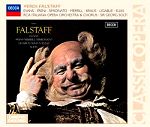 men
it is by a narrow margin with Freni
as Nannetta, Ligabue a fine Alice and
Simionato a fruity Quickly. Solti does
not over-drive the orchestra in the
Toscanini manner. This recording now
available on Decca’s Classic Opera series
with libretto, is an excellent audio
choice (475 6677). Three years after
Solti, Bernstein recorded a version
based on performances in Vienna. As
far as I am concerned, the casting of
Fischer-Dieskau as the ultimate non-Italianate
Falstaff puts this performance’s many
virtues out of court. Nor do I find
much virtue in Gabriel Bacquier’s Falstaff
on Solti’s second recording of 1979
(Decca, nla) nor Karajan’s with an ageing
Taddei recorded the following year (DG
447 686-2). Hardly had DG issued Karajan
2 when they recorded Giulini in a live
performance from Los Angeles with Renato
Bruson a vocally burnished and characterful
Falstaff. This production was recorded
for video at London’s Covent Garden
and is better enjoyed in that format
(see below). Colin Davis recorded
his first version in 1992 for BMG. A
colleague finds more virtues in the
conducting and singing than I do (Review).
Davis’s repeat on the LSO Live bargain
label has only the virtue of price.
Abbado and John Eliot Gardiner conduct
the most recent recordings. Both lack
Italianata, particularly important with
the women and their fleeting chatter
and laughter to Verdi’s rapidly moving
melodic lines. Abbado with Bryn Terfel
as the knight has the most to commend
it. I think Terfel will bring more to
the role of Falstaff with continuing
stage experience (Review).
Admirers of the period instrument approach
may find enjoyment in John Eliot Gardiner’s
recording with Jean Philippe Lafont
as Falstaff and Hillevi Martinpelto
as Alice. In Paris’s Chatelet theatre
I found him unsteady and her unwieldy;
they are a little better on record.
I was lucky though that the Fenton was
Jean Diego Florez far surpassing his
counterpart on the recording. My personal
audio shelves still favour Karajan with
Gobbi and Solti with Evans.
men
it is by a narrow margin with Freni
as Nannetta, Ligabue a fine Alice and
Simionato a fruity Quickly. Solti does
not over-drive the orchestra in the
Toscanini manner. This recording now
available on Decca’s Classic Opera series
with libretto, is an excellent audio
choice (475 6677). Three years after
Solti, Bernstein recorded a version
based on performances in Vienna. As
far as I am concerned, the casting of
Fischer-Dieskau as the ultimate non-Italianate
Falstaff puts this performance’s many
virtues out of court. Nor do I find
much virtue in Gabriel Bacquier’s Falstaff
on Solti’s second recording of 1979
(Decca, nla) nor Karajan’s with an ageing
Taddei recorded the following year (DG
447 686-2). Hardly had DG issued Karajan
2 when they recorded Giulini in a live
performance from Los Angeles with Renato
Bruson a vocally burnished and characterful
Falstaff. This production was recorded
for video at London’s Covent Garden
and is better enjoyed in that format
(see below). Colin Davis recorded
his first version in 1992 for BMG. A
colleague finds more virtues in the
conducting and singing than I do (Review).
Davis’s repeat on the LSO Live bargain
label has only the virtue of price.
Abbado and John Eliot Gardiner conduct
the most recent recordings. Both lack
Italianata, particularly important with
the women and their fleeting chatter
and laughter to Verdi’s rapidly moving
melodic lines. Abbado with Bryn Terfel
as the knight has the most to commend
it. I think Terfel will bring more to
the role of Falstaff with continuing
stage experience (Review).
Admirers of the period instrument approach
may find enjoyment in John Eliot Gardiner’s
recording with Jean Philippe Lafont
as Falstaff and Hillevi Martinpelto
as Alice. In Paris’s Chatelet theatre
I found him unsteady and her unwieldy;
they are a little better on record.
I was lucky though that the Fenton was
Jean Diego Florez far surpassing his
counterpart on the recording. My personal
audio shelves still favour Karajan with
Gobbi and Solti with Evans.
On DVD for Falstaff
there is good choice of production styles
and recording dates. The earliest from
1956 is a black and white mono recording
by Italian television. With Serafin
on the rostrum and a wonderful Italian
core cast of Taddei as Falstaff, Rosanna
Carteri as Alice and Barbieri as Quickly,
complemented by Luigi Alva and Anna
Moffo as Fenton and Nannetta, it is
a collector’s dream (Video Arts International
VAIDVD4333). A 1976 performance from
Glyndebourne is given in tasteful house
style with Donald Gramm and Ben Luxon
as Falstaff and Ford. The cast, Nucci
Condo’s Quickly excepted, lack a degree
of Italianata. There are some performance
cuts (Arthaus 101 083). Italianata is
also a quality lacking in the 1987 performance
from Brussels under Cambreling in Luis
Pasqual’s production. But it does not
stop José van Dam portraying
a warm-hearted aristocratic knight (Warner
5050467 4469-2-2). These productions
do contrast sharply with Graham Vick’s
over-coloured and overactive Covent
Garden 1999 production with Bryn Terfel,
conducted by Haitink (BBC Pioneer 1025).
This somewhat wacky approach is increasingly
typical of the modern producer. Luca
Ronconi’s 2006 staging from Florence,
conducted by Mehta, has it in a somewhat
different way (Review).
Perhaps the most traditional staging
is that by 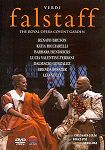 Ronald
Eyre prepared specifically for Giulini’s
return to the opera pit in 1982 and
performed in Los Angeles, London and
Florence. Renato Bruson’s avuncular
Falstaff has a twinkle in his eye to
match his burnished tone in a very good
all-round cast (Review).
A more modern recording of a traditional
production is that conducted by Muti
from the tiny Teatro Verdi in Busseto.
It was given in 2001 to mark the centenary
of Verdi’s death in a replica of staging
of that performed in the same theatre
in 1913 conducted by Toscanini. The
performance has the benefit of 16:9
format as well as Muti’s strict reading.
The vocal size of Ambrogio Maestri’s
Falstaff matches his physical dimensions,
not that the later inhibits his acting
or movements whilst the former is used
to inform his verbal nuance and the
variety of colour of his singing. The
wives are well matched and Roberto Frontali
is a strong Ford whilst Inva Mula and
Juan Diego Florez are vocally mellifluent
lovers. The impact of the production
can only be faulted by the restricted
stage size of the small Busseto theatre
(TDK DV-OPFAL).
Ronald
Eyre prepared specifically for Giulini’s
return to the opera pit in 1982 and
performed in Los Angeles, London and
Florence. Renato Bruson’s avuncular
Falstaff has a twinkle in his eye to
match his burnished tone in a very good
all-round cast (Review).
A more modern recording of a traditional
production is that conducted by Muti
from the tiny Teatro Verdi in Busseto.
It was given in 2001 to mark the centenary
of Verdi’s death in a replica of staging
of that performed in the same theatre
in 1913 conducted by Toscanini. The
performance has the benefit of 16:9
format as well as Muti’s strict reading.
The vocal size of Ambrogio Maestri’s
Falstaff matches his physical dimensions,
not that the later inhibits his acting
or movements whilst the former is used
to inform his verbal nuance and the
variety of colour of his singing. The
wives are well matched and Roberto Frontali
is a strong Ford whilst Inva Mula and
Juan Diego Florez are vocally mellifluent
lovers. The impact of the production
can only be faulted by the restricted
stage size of the small Busseto theatre
(TDK DV-OPFAL).
Verdi’s Falstaff,
his final opera, ‘my little enjoyment’
as he called it, was all he could have
hoped for and was a triumph at its premiere
at La Scala on 9 February 1893. The
greatest Italian composer ever was 80
years of age. It was a magnificent culmination
to a great career. After the La Scala
production of Falstaff Verdi
went to Rome to supervise a staging
there for which he made definitive alterations.
In Rome he was made an Honorary Citizen
after which the octogenarian composer
returned home to rest. Everyone hoped
that he and Boito might collaborate
on another Shakespearean opera, and
Boito actually suggested ‘Antony and
Cleopatra’, which he had recently translated.
Giuseppina warned Boito that Verdi was
now too old and tired. He did compose
ballet music for the Paris production
of 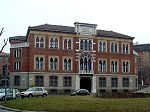 Otello
and travelled to the city for the premiere
in October 1894 after which he received
the Grand Cross of the Legion of Honour.
After the festivities in Paris Verdi
and his wife went to Genoa for the winter.
His mind was now focused on the construction
of The
Casa di Riposo, the rest home for
musicians, in Milan to which he appoi
nted Boito’s elder brother the architect.
The realisation of this project was
to occupy him in his last years.
Otello
and travelled to the city for the premiere
in October 1894 after which he received
the Grand Cross of the Legion of Honour.
After the festivities in Paris Verdi
and his wife went to Genoa for the winter.
His mind was now focused on the construction
of The
Casa di Riposo, the rest home for
musicians, in Milan to which he appoi
nted Boito’s elder brother the architect.
The realisation of this project was
to occupy him in his last years.
In the November 1897
Giuseppina contracted pneumonia and
died at the age of 82. Verdi was desolated.
A prima donna at the time of his first
opera, she had first been his adviser
as to fees, then in turn mistress, wife
and companion. She not only loved Verdi
but revered him too. But her understanding
of him as an artist stands out as truly
extraordinary. She never tried to influence
the direction of his composition, tolerated
her exclusion from his life during the
creative process, his elation immediately
after a premiere and the depression
that followed. Giuseppina discounted
the theatre rumours that surrounded
Verdi’s relationship with Teresa Stoltz
for a period, remaining a firm friend
of the redoubtable soprano who sang
Aida in the first Italian production
and the soprano role in the premiere
of the Requiem which she toured
the work with the composer. She never
doubted that his composing was the point
on which all their life should focus,
and for this the operatic world should
be ever grateful. Her will concluded
with the words Now, addio, mio Verdi.
As we were united in life, may God
rejoin our spirits in heaven. She
was buried in Milan after which Verdi
returned alone to Sant’ Agata.
Verdi was physically
shaken by Strepponi’s death and complained
that his hand trembled and his legs
would not support him. He wrote to a
friend I am not sick, but I am too
old. Younger friends such as Boito,
Stoltz and Ricordi visited him but all
the friends of his generation who had
lived the years of the Risorgimento
and unification were dead. He was lonely
and spent more time in Milan where he
physically watched over the construction
of the Casa di Riposio, knowing every
detail even the costs of materials;
through his constant attendance it became
known locally as Casa Verdi. He also
had to estimate the cost of endowing
the foundation and how to endow it.
After establishing it as a charitable
foundation he bequeathed the building
itself, Treasury Bonds, two hundred
thousand lire and the Italian and foreign
royalties from his operatic compositions.
It exists to this day.
Verdi’s final compositions
were the Te Deum and Stabat
Mater referred to earlier. These,
together with the Laudi alla Vergine
Maria were premiered in Paris after
Boito made the necessary arrangements.
The Quattro pezzi sacri can be
found as a single CD with Arleen Augér,
backed by Swedish choral forces conducted
by Muti (EMI 0777 747066 2). It also
commonly appears as a double with the
Requiem where two recordings
stand out. John Eliot Gardiner’s uses
a period instrument band (Philips 442
142-2), whilst the second, conducted
by Mehta in 1970, is alongside a performance
of the Requiem featuring Leontyne
Price and Jussi Björling and conducted
by Fritz Reiner in a Decca Legends
double CD (467 111-2). A more recent
DG recording has the Quattro pezzi
sacri and other sacred works that
Verdi composed conducted by Myung-Whun
Chung with Carmela Remigio and the forces
of Santa Cecilia, Rome (469 075-2).
On 21 January 1901
as he was dressing in his suite in the
Grand Hotel in Milan Verdi suffered
a stroke. He survived, unconscious until
the early morning of 27 January when
he died. In that period the hotel was
draped in black and straw laid down
in the streets to deaden the noise of
traffic. As he stipulated he was laid
to rest alongside his wife in the Milan
municipal cemetery without music or
singing. A month later both coffins
were removed to the now completed Casa
di Riposo on a specially built carriage
and where they now lie. Two hundred
thousand people lined the streets, wreaths
arrived from all over the world and
Royalty and members of the Italian Parliament
followed the procession. Arturo Toscanini
conducted a choir of eight hundred in
a rendition of Va pensiero, sull’
ali dorate from his Nabucco.
So passed the greatest of all Italian
composers whose works, together with
those of Mozart, form the backbone of
the repertoire of every opera house
in the world. At least his genius and
greatness were recognised in his lifetime.
Viva Verdi!
Appendix.
Collections of overtures, choruses
and arias. Acknowledgements.
Probably the best place
to start is with collections of overtures
and preludes from various operas.
A two-disc collection
with Karajan conducting the Berlin Phil
has nineteen at mid-price (453 058-2).
On the same label and with the same
orchestra is a single disc collection
from Abbado featuring those overtures
that appear regularly in orchestral
concert programmes, such as Nabucco,
Forza and I Vespri Siciliani,
as well as six others (457 627-2). Both
recordings are commendable. The most
complete collection, and one of the
most recommendable ones, is that recorded
by Chandos and conducted by Sir Edward
Downes, one of the most reliable of
all Verdi conductors. The four-disc
collection was issued at mid-price in
2001 for the anniversary of Verdi’s
death. It also includes the ballet music
composed for various operas for performance
in Paris at The Opéra (Review).
The discs are available separately.
Also worthy of consideration at mid-price
is a collection of overtures and ballet
music conducted by Riccardo Chailly
with the National Philharmonic Orchestra,
a superb session band, recorded in top
rank Decca Digital sound (Decca 448
238-2). There are excellent collections
of popular choruses from Sir George
Solti and the Chicago Symphony and Chorus
(Decca 430 226-2). But, if you, like
me believe the sound of an Italian chorus
has that particular squilla,
then the La Scala forces appear under
Muti on EMI’s Red Line label is a strong
favourite (7243 569846-20).
The record companies
have recognised the popularity of Verdi
with collections of arias by individual
singers as well as general compilations.
Sometimes these have been purpose-made
whilst other collections are taken from
singer’s recordings of complete operas.
In respect of sopranos, and although
I have not harked back to historical
issues in this conspectus, one of the
greatest was Rosa Ponselle. Naxos
have her singing Verdi in a Ward Marston
re-mastering from a variety of 78rpm
sources (Review).
Zinka Milanov, a widely recognised Verdi
interpreter succeeded Ponselle as reigning
diva at the met in the 1940s and 50s.
A Nimbus collection shows off her skills
albeit she is caught a little past her
prime (Review).
Milanov was in turn succeeded at the
Met by Leontyne Price one of the greatest
of Verdi spinto sopranos of the latter
half of the 20th century.
She recorded mainly for RCA who issued
a compilation disc of Verdi arias (
RD 87016) and a collection of Verdi
and Puccini duets with Placido Domingo,
both from her complete recordings (09026
61634 2). An earlier CD from LPs made
early in her career is shared between
Verdi and Puccini but is rather short
measure (Review)
In my review of a collection of Verdi
arias by the Latvian dramatic soprano
Inessa Galante I suggested she was a
worthy successor to Milanov. Her singing
and characterisation is of a high quality
(Review).
Angela Gheorghiu is a more lyrical voiced
soprano. Her recording of arias from
nine Verdi operas, including extended
extracts from Don Carlo and Otello under
Chailly’s baton, is another firm recommendation
(Review).
Gheorghiu shares a duet disc entitled
Verdi per due with her husband
Roberto Alagna conducted by Abbado.
The conductor persuades the tenor into
some more shapely singing of the composer’s
works than is often the case with him
(EMI 7243 5 56656 2). As far as I am
aware neither Renata Tebaldi nor Montserrat
Caballé have discs devoted solely
to Verdi although both were distinguished
interpreters of his music. A two disc
Decca issue entitled La Tebaldi
has eight Verdi items among its twenty
four (430 481-2) whilst Caballé’s
admired Verdi Rarities LP collection
of eight of the composer’s lesser known
operas is now included in a double CD
from RCA (GD 60941). An EMI collection
taken from operas Caballé recorded
for that company shares her Verdi with
Bellini (7243 574558 2). Somewhat less
distinguished, but worthwhile is a Sony
CD in their Essential Classics Series
that features two very different divas,
the dramatic Renato Scotto and light
coloratura of Ileana Cotrubas, singing
arias from nine Verdi operas (SBK 67
180).
Verdi wrote equally
well for tenors as for sopranos, a fact
recognised by the singers themselves
as well as by the various record companies.
Philips issued a box set of Carlo Bergonzi,
that prince of Verdi tenors, singing
thirty-one arias. Some were taken from
complete sets and illustrate his evenly
produced tone, near faultless phrasing
and sense of Verdian style. Others were
recorded later, specifically to complete
the collection, and find the tenor a
little past his considerable best. (Philips
432 486-2). Deutsche Grammophon did
a similar thing with Placido Domingo
with a trawl of the tenor arias from
all twenty-eight of the composer’s operas.
Spread over four CDs and with 303 minutes
of music it is the most comprehensive
collection of the composer’s writing
for the tenor voice (471 335-2). A colleague
reviews
a single CD selection of fourteen items
from this collection. An RCA collection
titled Domingo Verdi Heroes has
seventeen extracts from recordings made
early in his career for RCA including
from his first recorded Otello (09026
68446 2). Bergonzi can be heard at his
best in a double CD issue from Decca
titled Carlo Bergonzi. The sublime
voice. No fewer than twenty-three
of the forty items are from Verdi opera
recordings set down when the tenor was
in prime voice (467 023-2). Decca also
issued a collection by Pavarotti from
recordings made in his prime in the
late 1960s and 1970s when his well-supported
open-toned voice was at its best (417
750-2). A most interesting recording
has Pavarotti away from his contracted
company in disc titled Pavarotti
Premieres. The eight tracks claim
first recordings of six alternative
arias Verdi composed for specific singers
in performances of Ernani, Attila,
I Due Foscari and I Vespri
Siciliani plus the rarely heard
Aida overture and Simon Boccanegra
prelude. Claudio Abbado is the tasteful
conductor (CBS MK 37228). Of more recent
tenors to aspire to the crown of the
three already mentioned, Ramon Vargas
(RCA 74321 79603-2) has a better sense
of Verdian style than Roberto Alagna
(Review).
However, neither singer is in the same
league as his illustrious predecessors.
Scarcity of dedicated
Verdi collections from the lower register
voices reflects the market. One recent
dedicated Verdi CD, specifically recorded
as distinct from being derived from
complete recordings, features the American
baritone Thomas Hampson. Not the first
name you might think of in Verdi, but
his fine legato and well-covered tone
contributes to a worthwhile collection
of eleven tracks with only two from
the best known of Verdi operas, the
remaining ones being from the composer’s
lesser-known early works (EMI CDC5 57113-2).
No more natural Verdian baritone than
Tito Gobbi graced the stage from the
1940s into the early 1970s. A two-disc
set entitled The Very Best of Tito
Gobbi has the whole of the second
disc devoted to the great baritone singing
arias from ten Verdi operas (7243 5
85096 2). During a similar period as
Gobbi the smoother-toned American Robert
Merrill, who contributed to many RCA
and Decca recordings was also active
on stage, mainly at The Met, and in
recordings. There was constant debate
among opera cognoscenti as to their
relative merits. A CD in Decca’s Classic
Recitals series, derived from an
LP album of 1963, has him singing six
arias from five Verdi operas in a rather
sparsely timed CD (475 396-2). Another
famous American Verdi interpreter in
the theatre and on record was Sherrill
Milnes. In the 1970s he recorded Verdi
operas for several record companies.
A collection in Decca’s Grandi Voci
series includes eight tracks of Verdi
among the fifteen on the disc (443 929-2).
Verdi’s writing for
the basso cantante voice as priest,
king or implacable foe is among his
finest creations. The Bulgarian bass
Boris Christoff was unparalleled in
his portrayal of Philip in Don Carlo.
He recorded the soliloquy Ella giammai
mamo in 1949 for issue on 78rpm
shellac as well as recording the role
complete alongside Gobbi five years
later. Christoff’s recordings of seven
of Verdi’s great arias for the bass
voice are available on EMI Références
series titled Italian Opera Arias
devoted to the great bass (CDM 7 69549
2). His compatriot, Nicolai Ghiaurov,
mainly recorded for Decca but his Verdi
seems to be spread over several compilations.
By comparison EMI did issue a disc titled
Airs d’opéras Italiens
featuring Ruggero Raimondi with all
but one of the eight tracks devoted
to Verdi (CDM 7 69549 2). The American
Sam Ramey, a bass favoured by various
recording companies, has five of Verdi’s
bass arias included in his EMI Airs
d’Opéras CD (CDC 7 49582
2). Once thought of as the successor
to Christoff and Ghiaurov, the Georgian
bass Paata Burchuladze made an impressive
CD in London in 1984 that features four
Verdi arias among its eight tracks.
His dark voice is steady and sonorous
if a little glottal in production. Regrettably
the singer failed to fulfil the potential
this disc foretold which does not detract
from its virtues. Edward Downes is the
idiomatic conductor (Decca 414 335-2).
I am not aware of any
discs devoted to mezzos singing the
various arias Verdi wrote for that register
in Ballo in Maschera, Forza
del Destino, Don Carlo and
Aida. Some are to be heard in
two excellent double CD compilations
prepared for the Verdi anniversary in
2001. The first from DG, titled The
Force of Destiny has 42 tracks taken
from their extensive catalogue of recorded
opera. It has a well-balanced programme
of arias and choruses. Its only fault
is that the items have neither chronological
nor thematic cohesion; enjoyable nonetheless.
Decca’s offering entitled Viva Verdi
A 100th Anniversary Celebration
came complete with biographical detail
of the great composer and a synopsis
of each of his operas to go alongside
at least one item from each. The selections
are drawn from the Decca, Philips and
DG catalogue and are excellent in quality
of recording and performance. The double
disc selection concludes with the Requiem
aeternam, Kyrie with Joan Sutherland,
Marilyn Horne, Luciano Pavarotti and
Martti Talvela conducted by Solti. A
very fitting finish to a well-titled
and presented celebration of Verdi’s
anniversary. A DVD of a concert
conducted by Abbado in the Berlin Philharmonie
on 31 December 2000, the eve of the
Verdi anniversary, has scenes and arias
from five operas and is a very fitting
finale to this survey (Review).
Acknowledgements
In preparing this conspectus I have
been indebted to the following sources:-
- The Operas of Verdi. Julian
Budden. Three Volumes. Cassell 1973,
1978 and 1981
- Verdi. The Master Musicians
Series. Julian Budden. Dent 1985
- Verdi. His Music, Life and Times.
George Martin. Macmillan 1965
- The Complete Operas of Verdi.
Charles Osborne. Pan 1969
- Verdi, A life in the Theatre.
Charles Osborne. Weidenfeld and Nicholson
1987
- Verdi and His Operas. New
Grove Composers Series. Roger Parker
edited Stanley Sadie. Macmillan Reference
2000
- Divas and Scholars. Performing
Italian Opera. Philip Gossett.
University of Chicago 2006.
- Innumerable CD booklet and sleeve-notes
Robert J Farr (July 2007)

